#the mods club and rockers club are just mods and rockers. they have the same time to annoy each other
Explore tagged Tumblr posts
Text
made a sorta 1970's hogwarts school timetable in word. please tell me if you have any clubs or such you think they'd have
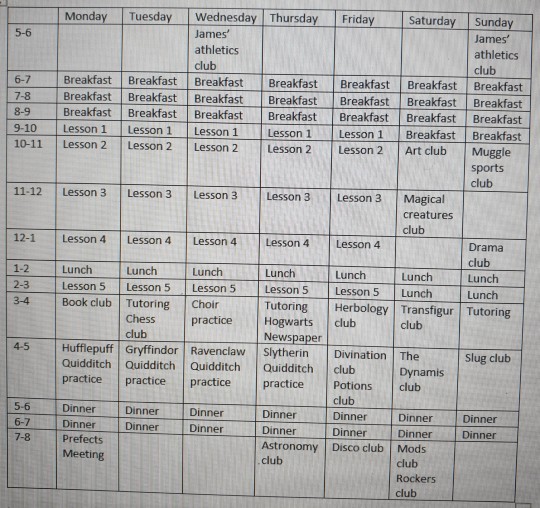
#the tutoring is just like. booked rooms in the library for school assigned tutoring. so like tutors will have their tutees at that time.#james' club is literally just him going for runs in the mornings and trying to drag his friends along#disco club was only a club during the 70s and a little into the 80s. mary macdonald started it.#<- it's literally just a school approved way to party. they get the great hall. play disco music and dance.#the dynamis club is one of those weird prestigious clubs (like slug club by run by students)#<- it's basically just a gathering of the rich purebloods. started by the black family a long time ago. sirius was invited but refused#the mods club and rockers club are just mods and rockers. they have the same time to annoy each other#muggle sports club is like. where they do a different muggle sport every week. lily and james are both in it and bond a lot because of it.#marauders era#marauders#hogwarts
15 notes
·
View notes
Text
APH Music Headcannons
America
-Mainly listens to mainstream pop- think Ariana Grande, Carly Rae Jepsen, Lady Gaga, Miley Cyrus
-He is open to most types of music tho, his music library (collects CDs and vinyls but also has Spotify) is really chaotic because of this
-Has a really soft spot for country and rockabilly, he was once a cowboy and still loves that time of his life, the music he listens to just reminds him of that time. They are also really fun songs to dance to, something he loves doing
-He likes to tease England that the Beatles were inspired by rockabilly and Chuck Berry- things to come out of his land. England hates being reminded of this
-Partial to British music, as seen with the British Invasion of the 60s, but tries to hide this fact from England, he doesn't need him to brag about it
-Doesn't listen to the radio despite liking the kind of music mainly played on it, he just hates the commercials as well as how very station only plays the same ten songs
England
-Was a huge punk during the 70s and 80s, his government got really angry about this (mainly his clothes and many new piercings) but in true punk fashion, he didn't care
-He has gone to dance clubs with live bands since the first one popped up in England. Still goes to them but misses the ones from the 60s and 70s
-Was a Mod during the 60s- he did listen to Rocker music but didn't subscribe to their philosophy or fashions
-Was part of the under ground music scene, his dedication to it started in the 60s with garage rock- garage rock was also the gateway into punk when it was created the next decade
-Tried to start a band but couldn't find anyone else who wanted to join and play the same kind of music
-A huge fan of the Beatles, and no it's not because everyone else likes them, he liked them first- definitely brags that he saw them first as The Quarrymen
-He doesn't like modern music much but keeps an eye out for the next 'Beatles'
-Does like King Gizzard and the Lizard Wizard, they remind him of psychedelic live music drug dens he used to go to in the 60s
-When sea shanties got popular again he almost cried tears of joy
France
-Doesn't care for Édith Piaf, he's embarrassed about this so he has some of her vinyls to keep up appearances apparently he's not "French enough" if he doesn't He sometimes listens to them to see if his opinion has changed, but he always comes from it still disliking her stuff
-Prefers Yves Montand
-Huge fan of opera, tries to go as much as he can, even when he's in another country for a meeting (Austria goes with him when he's available)
-Fan of the French indie pop scene, just a big fan of all indie music
-Loves a good romance song- as a soft spot for crooners like Frank Sinatra, in his opinion they have the best love songs
Russia
-Only listens to Boney M's Rasputin
-The Baltics start crying the second time the song plays for that day
-He also really likes classical music, but he thinks the Baltics reaction to Rasputin is funny so he never plays anything else when they are around
Prussia
-A huge fan of punk and goth music
-Can be found at punk and goth clubs with Hungary and England
South Korea
-A huge fan of all pop, Kpop, Jpop, western pop, 90s pop, everything
-Also surprisingly a fan of western rap
27 notes
·
View notes
Note
media reccs? 👀 since apparently you are a man of good taste?
Wow thank you 😏 I have a masterlist of movies that have changed me I often recommend to people, I'll just copy and paste here with quick synopses lol, it's kinda long. I'm not super great at writing synopses tho so bear with me
Dead Poets Society (1989)
One of my favorite movies of all time and a total classic. It's about a group of boys at a strict boarding school who are inspired by their new English teacher (played by Robin Williams) to think for themselves and chase their dreams. This movie literally changed my life lol
Quadrophenia (1979)
This movie is based off of the story behind the concept album by The Who of the same name. It follow the life of a young man named Jimmy who is in a gang called the Mods. Theres this huge gang war between them and the Rockers (I think that's their name, it's been a while since i watched it) and Jimmy questions his beliefs about coming-of-age and his values in life throughout the film
Cabaret (1972)
Based off of the Broadway musical of the same name, this movie is about a British man who moves to Germany during the beginning of the rise of Nazis. He meets a woman who basically turns his world upside down, and it follows their love affair and sexuality and anti-semitism, and it's hilarious and heart wrenching and a beautiful movie
Eternal Sunshine of the Spotless Mind (2004)
This is a super trippy romance film. Basically in the universe of this movie, theres a technology that is developed that can delete memories of an entire person from your mind while you are in a dream-like state, and the main character of this movie (played by Jim Carrey) decides to undergo the procedure after a bad breakup. Its soooo good I highly recommend this movie
It's Such a Beautiful Day (2012)
This is an animated film about a man named Bill who is going through brain cancer. Its told from the perspective of an unnamed narrator essentially communicating everything Bill sees, hears, and experiences. This is the movie that got me into film and it is still a complete masterpiece and one of the most beautiful movies I've ever seen
The Dirties (2013)
Loved this one a lot back in high school, it's been a while since I watched it. This is a film made in Canada about a high schooler named Matt Johnson and his friend Owen who decide to make a short film for their class about them killing the gang at their school that bullies them, and things take a dark turn. It's a hilarious movie and hits pretty close to home for me in a lot of ways haha
Logan's Run (1976)
Great movie, pretty cheesy though so be warned. This is based off a book with the same name, and it takes place in the future where most of humanity is wiped out except for a small society that lives under a domed structure. No one is allowed to leave the dome, and to control overpopulation, no one is allowed to live past the age of 30. It's really bizarre but I love this movie
Donnie Darko (2001)
Pretty sure this was Jake Gyllenhaal's first big hit when he was super young (I think he was like 19 in this movie but I'm not sure) basically about this kid, Donnie Darko, who is somewhat schizophrenic and has a habit of sleepwalking. After one particular incident he has a near-death experience and starts seeing a man in a bunny costume everywhere who makes him do weird stuff. Another pretty trippy movie with a crazy ending
American Psycho (2000)
Honestly I'm sure a few on this list you've probably seen (most likely this one included) but I didnt wanna leave any out because they're all so good. If you haven't seen this, it's about a Wall Street executive named Patrick Bateman who is a materialistic phony by day and a serial killer by night. I tried to read the book but the inner dialogue was really hard to get through lmao. Awesome movie though huge recommend.
Clockwork Orange (1971)
Yet another trippy one. And fuck it's been a long time since I've seen it so I might get some stuff wrong here. But it's basically about this serial rapist guy who hangs out with this group of goons and they all like to go beat up homeless people and shit, but the main character gets captured and has to go through reformation therapy to make him a better person. It's an extremely bizarre movie but soooo good and kind of hilarious lol
Creep (2014)
Of course this is on my list haha. If you haven't seen it yet, it's a horror movie about this freelance film guy who answers an ad on craigslist to help a man with cancer film a movie for his unborn son. And shit gets weird real fast. One of my favorite horror movies ever, I wouldnt say it's super scary but it's fun as fuck
Hereditary (2018)
If I'm being honest, I don't like a lot of big movies made in super recent years and especially not horror movies (mostly because they're all cheap cash grabs with no substance) but this one is an exception for me. Hereditary is fucking masterful in my opinion, legitimately creepy as hell and well-produced and well written. To put the plot as vaguely as possible without spoiling anything, it's about a family (mostly the mother) who go through some crazy fucked up shit. That's literally all I can say without giving anything away. Super good flick, big recommend
Gattaca (1997)
This list isn't in any particular order, and I love all these movies to death, but if I had to rank them this would probably be on the lower end. It's not a bad movie, it's still great but it's just not as life-changing as the other ones lmao. This takes place in the future where genetic modifications have progressed to a point where you can modify your unborn child's DNA to have the perfect baby. This has led to, essentially racial bias against those who never had that procedure when they were born. The main character was not one of these "special" children, but he wants an extremely prestigious job which requires that of the employee. Through the film, he is trying to fake his identity and fool the company into thinking he is one of these perfect people. Still a great film
Fear and Loathing in Las Vegas (1998)
Johnny Depp, man, he is something else. I LOVE this movie. Based off a true story and a book written by the man who lived it, Hunter S. Thompson, this follows the adventure of the writer and his attorney as they go on a drugged-out, psychedelic romp through Las Vegas with the original intention being to cover a story on a motorcycle race, but things go off the rails as they both terrorize the entire city in a way. Just a fun ride the whole way, a great movie
The Truman Show (1998)
God I'm realizing this list is long as fuck. Don't watch all of these movies, it might take you a lifetime lmao. Anyway, this is a classic Jim Carrey movie and another one you've probably seen. But again, if you haven't, this movie is about a man whose entire life has been fabricated and shot for television without him knowing. Super great, super moving, fantastic film 10 outta 10 I gotta wrap this shit up
A Scanner Darkly (2006)
A lesser known Keanu Reeves movie, but fuck I wish more people have seen this. This is one of my favorite movies of all time, and it's based off a book which is just as amazing. This movie takes place in the near future, where facial recognition technology has progressed wayyy too far, and drugs have gotten to the point of no return. The plot follows a detective who is undercover in a junkie house trying to figure out who is the top of the drug dealing totem pole, but ends up wrapped in the junkie lifestyle a little too deeply. Seriously, I recommend this movie to everyone who asks, it's so damn good
Fight Club (1999)
Another popular one. If you havent seen it, it's based off a book by Chuck Palahniuk following the story of a man (the main character actually doesnt have a name lol) who meets a guy named Tyler Durden who changes his entire perspective on how the world works. They start an underground boxing club together to help themselves and other men blow off steam and get away from the capitalist consumer-centric lifestyle they are forced into. Big twist at the end, great movie five stars on yelp
Harold and Maude (1971)
This is a weird one. Gotta say. It's about a guy in his 20s who meets an old woman at a funeral and falls in love with her. Sounds pretty ok at face value but theres a lot of really strange subplots and a huuuuge twist at the end (one of the subplots being the guy compulsively fakes his suicide to get his mother's attention) big recommend
Polyester (1981)
This one I cant even explain u just have to watch it its fucking bizarre
Fargo (1996)
Ok lightning round on the synopses, this movie is about a man who wants to commit fraud by hiring guys to kidnap his wife so her father can pay them ransom and instead the husband gets the money but everything goes wrong it's really good
Bad Times at the El Royale (2018)
Another modern movie I actually like, last time I watched this I was on shrooms and it was crazy but it's about this hotel right on the border of california and (Nevada I think?) And all these weird people are staying at it and there are twists at every turn and chris hemsworth is a cult leader in it its great
Memento (2000)
GREAT MOVIE GOD PLEASE WATCH THIS ONE it's about a man who develops short term memory loss after witnessing the rape and murder of his wife AND WHEN I SAY THERE ARE TWISTS LIKE EVERY TEN MINUTES I MEAN IT. The film is chronologically backwards, in that the first scene takes place at the end of the story and works back from there in increments of like 5 minutes. Basically each scene is a segment of time that this guy remembers before his memory loss kicks in and he forgets and FUCK it's so good please god watch it
Almost Famous (2000)
This is another one that would probably be low on my ranking but still a great and fun movie, it's about this kid that wants to write articles about rock stars for the rolling stone (based off a true story btw) and he ends up running away to go ride on a tour bus with some band and gets into all types of shenanigans and its great and sad
Parasite (2019)
Another modern movie I love, fuck this is getting too long lmao. Poor family wants to make money and they hatch a scheme to pretend to be bougie and work for this rich family but shit gets weird and everything goes wrong and it's so good (also literally the only film ever that made me speechless afterwards)
Pulp Fiction (1994)
Pretty much lives up to the hype, I totally forgot the plot but it's pretty damn good I remember that lmao
The Warriors (1979)
Fun movie, theres a bunch of teen gangs in New York and the leader of all of em is like "hey we should rally all the gangs together and fuck up the cops so we can rule this city" but then he gets shot by someone in the crowd and the gang The Warriors gets blamed so the whole movie is them running from all the other gangs so they can get back to home base and it's just an all around fun time movie
12 Monkeys (1995)
THIS MOVJE IS CRAZY it takes place in the future where a virus has almost completely wiped humans off the face of the earth so these scientists send this guy back in time to figure out where it came from so they can stop it from ever happening but obviously everything goes wrong and yadda yadda yadda it's amazing
Waking Life (2001)
Gonna preface this by saying this film is definitely not for entertainment, it's kind of an arthouse-type flick. It's the type of movie you have to think really really hard about to watch. The basic plot is the main character is stuck inside his own lucid dream, and is walking around listening to all these characters in his dream talk to him about, idk like the meaning of life and consciousness and shit. It's really good if you're in the mood for that type of thing.
Okay I'm finally done, you probably didnt expect this but I've been meaning to put my movie recommendations on this blog anyway haha. I deleted some just cause it was getting wayyyy too long. If u want a shorter list I can just give u like a top 5 in DMs but there u go have at it, every movie on that list is a banger I swear
#long post#movies#film#cinema#cinephile#ask#movie recommendations#you have no obligation to read all that#really shows how bored i am that i wrote out this whole fuckin thing on my phone lmao#youre welcome?
26 notes
·
View notes
Text
okay it’s time for some rhythm ranting (i came up with that and i am so fucking proud of myself for it)-
so rhythm heaven megamix is the fourth rhythm heaven game, preceded by three other games (as you may guess): rhythm tengoku for the gameboy advance, released in 2006 in japan only, rhythm heaven for the ds, released in 2009, and rhythm heaven fever, released for the wii in 2011/2012 and for the wii u in 2016. as megamix’s name implies (esp it’s japanese/korean name, rhythm tengoku (in japan)/rhythm world (in korea) the best+), it’s a mix of lots of rhythm games from past games. not all of them, though, because the developers wanted to spite us by not putting bon odori in. /j oh and like people like dj school and shit and it’s not in it. people modded dj school in though, no i am not kidding, people literally modded in a full game and i don’t know how. i mean donk-donk and tambourine have also been modded in somewhat for remixes but anyways back to my point-
the rest of this’ll be under the cut tho-
so one of my main problems with megamix is some of the game choices. rhythm tengoku only had 25 unique, non-sequel rhythm games. out of those, nine were excluded. that’s almost half. for perspective, though, three of those games are bon odori, rap men, and toss boys, which basically need audio cues to be played. bon odori relies on it’s song, where you clap whenever they say “pan” and clap twice quickly when they say “panpa”, rap men relies on its audio and you do something different depending on three different kinds of cues, and for toss boys you need audio cues to know who it’s being tossed to. and logically, they’d likely want to translate the games, so given that they seemingly didn’t get that big of a budget for dubbing, they weren’t included... but quiz show was. what’s the problem with quiz show, you may ask? well rhythm heaven as a game is a rhythm game. quiz show literally doesn’t require rhythm. basically the host will press the button a certain number of times and in order to pass the game you just need to press it the same amount of times. that’s literally it. in megamix you get the game’s skill star if you press it to the same rhythm, but it’s still not required. it’s also dumb because you literally have to play it perfectly in order to pass it. all you need for a perfect is to press the button(s) the same amount of times. if you press a button the wrong number of times, the game ends once the number you were supposed to hit it is revealed. quiz show is literally pointless. the only times it’s used well are in remixes in tengoku. in remix 6, at least in silver, it uses the previously played game, the clappy trio, as a hint, with the host asking, “how many members are in the clappy trio?”, before hitting the buttons three times. in remix 4, the rhythm for both the quiz segments goes with the music. i mean on the last one he can add an extra press and it’s fucking bullshit but whatever. i’m not mad. but my point is that in megamix, they added a game that doesn’t require rhythm as opposed to a multitude of actually liked games from tengoku. there’s non-included games that don’t require audio cues, i should add. showtime, polyrhythm, tram and pauline, wizard’s waltz, and for fuck’s sake, thinking about it, the games that likely weren’t added because of audio cues wouldn’t HAVE to be dubbed. just do what the tengoku fan translation did and translate the on-screen subtitles but leave the audio in japanese. please just give us bon odori stop holding them hostage-
i talk about tengoku but i’m pretty sure rhds is the game with the most non-included minigames. ds was played sideways, almost purely using the touch screen with the exception of rockers 2 in the last set of games. it had a unique control scheme, with three types of controls: tapping, where you just tap the screen with the stylus or your finger; flicking, where you flick your stylus or finger like you’re making the end of a checkmark, according to “the secret of flicking” reading material thingie you can read when you unlock the cafe; and sliding, where you just. slide your finger. megamix only has tapping, and even then that’s only when you’re using simple tap mode and i don’t want to imagine how that handles games that use the b-button. as i mentioned, tengoku had almost half of its games missing. ds has twenty-five rhythm games if you include the credits game airboarder. ten of those weren’t included. that may not seem like a lot, but ds is most peoples’ favorite rhythm heaven game, and two of the most loved games in the fandom, dj school and love lab, are from rhds, and neither was included in megamix.
fever has the least cut games over all, with only five of its original rhythm games being cut. fever had twenty-nine original rhythm games, with one more (rhythm test) also appearing in its remix 10. the ones that didn’t make it in are tambourine, donk-donk, tap troupe, shrimp shuffle, and night walk. night walk’s exclusion was probably since gba night walk made it in and they didn’t know how to name them differently, bUT YOU DID IT WITH THE KARATE MAN GAMES??? DID WE REALLY NEED ALL OF THE KARATE MAN GAMES, A PREQUEL, AND A NEW GAME? THAT’S FIVE DIFFERENT KARATE MAN GAMES IN MEGAMIX. THAT’S TOO MANY TIMES TO PLAY THE SAME GAME. granted only three of those times are required to beat the game (prequel karate man, gba karate man/karate man returns!, and karate man senior), but my point still stands, they gave us literally every karate man game but not night walk or something. it’s especially dumb to me because they gave figure fighter both a prequel and its sequel because they looove figure fighter... instead of including shrimp shuffle, which really desperately needs to be included, please let me know what a frame-perfect input looks like so i don’t keep getting barelys that look fine because like all my inputs are barelys but they still break the perfect-
,,, onto another thing before i break something or kill someone.
so the dubbing for megamix is a little odd. as i said, the game likely didn’t have that big of a budget for dubbing, especially when compared to other games in the series. the prologues for games use the same three or four generic fonts despite the japanese version using the original fonts, the returning games that have lyrical songs just use the original version of the song with the exception of fan club 2, the two lyrical remixes weren’t dubbed (komeki no story, lush remix’s song, is simply instrumental with english audio, while in the japanese version it has lyrics. i’m a lady now, honeybee remix’s song, is in english regardless of audio), and lastly,,, the dubbing for the returning tengoku games where there’s vocals.
so in space dance, the whole game uses audio cues. there’s three of them in total: “turn right”, where you press the right d-pad button on “right”. note that when they say it it does not sound like they are saying turn right. at all. i’m not sure why, it’s not just the gba’s bad sound quality because well. bon odori exists. and also because it’s the same in megamix when you use the japanese audio. my immediate thought is accents but i don’t know if japanese accents are a thing. might just be because of the fact that japanese people tend to pronounce r’s as l’s? not sure though. “let’s sit down”, where you press the down d-pad button on “down”. it also doesn’t sound like they’re saying “let’s sit down”. and lastly, “pu-pu-pu-punch”, where you press the a-button on “punch”. in order to punch. because that’s a dance move. like seriously, space dance is fun but how is this a dance? um anyways, in the english version of megamix they changed it so it’s more clear what’s being said but the dubbing’s not the best. firstly, they changed “turn right” to “and pose” even though that is definitely not posing. it’s weird since. that’s the only one that was changed. i don’t know how to describe what they did to space dance and most of y’all probably don’t play rhythm heaven so you don’t understand, so here’s a perfect gameplay of space dance with japanese audio (it took time to find), and here’s one with english audio. ,,, okay so the english one’s of cosmic dance because i. forgot what exactly i was doing. and got distracted looking through the comments. so now i know that they still reused space gramps’ voice for cosmic girl in cosmic dance. which like. wut? you redubbed it but you. you still reused. you still reused space gramps’ voice for her? megamix dubbers are you okay? i’m kind of concerned.
the other game that has audio is purely japanese audio. marcher/marching orders. it’s a keep the beat game where you play as a squadmate following the sarge’s orders. the rhythm heaven wiki’s description for it is basically what i said but they’re better at describing things then me so.
“In this game, a rookie is undergoing marching training with her squadmates while following their Sarge's orders. The player controls the rookie at the end of the line. There are four commands that the Sarge will yell.
"Attention, March!"
"Attention, Halt!"
"Left-face, Turn!"
"Right-face, Turn!"
The player must perform these with proper timing along with the other squadmates. Just before the game ends, the squadmates will be moved offscreen, still marching as the game ends.”
in the japanese version, the commands he says are obviously different, though i. do not know what he is saying. so have my attempts at romanizing it.
“gento susume!” = “attention, march!”
“gento commoback!” = “attention, halt!”
“meski meek!” = one of them? i don’t really know which and it feels inconsistent, at least in marcher 2. i think it’s right-face turn but i’m not one hundred percent sure.
“meski peek!” = the other one. so i think left-face turn.
,,, yeah i don’t know japanese, sorry if this (as in literally any of this) is offensive to anyone that does. i’m just trying my best. the wiki doesn’t say what he says in the japanese version. unlike for other games.
now in the japanese version, the sarge has a somewhat deep voice. but in the english version... he doesn’t.
um here’s a perfect in tengoku and here’s one in megamix that i think has english audio since. it says it’s the english version in the description. but i’m not listening to it.
u h my last nitpick with megamix is the prequels. so prior to lush remix, almost all the games played are prequels, easier and shorter versions of the actual games. after lush remix is completed and the towers of lush woods are unlocked (i’m just taking this from the wiki, wtf is lush woods), all the games from then on are the original versions, with “2″ or something else stuck onto them for the games that had prequels. this makes it irritating to find certain games on the wiki because it’s just like “no i don’t want normal wii micro-row i want wii micro-row 2 rhythm heaven wiki please” or whatever. also the picks for games that have prequels are all over the place, and some of the prequels’ music doesn’t seem to fit and makes it feel like all the patterns in the prequels for games like rhythm tweezers and clappy trio are the exact same. is it the exact same? because if so then that’s cool (i suck at rhythm tweezers and clappy trio-) but also very boring. i get that they wanted to start people with something easy but some of the games that have prequels were already easy. karate man (gba) is literally the first game in tengoku but it still has a prequel. rhythm tweezers is the second game but it has a prequel. clappy trio’s the fifth and it has a prequel (granted it is kind of hard). fillbots is the third in ds and it has a prequel. air rally is relatively early on in fever. you get my point. and the weird thing is that in some cases at least, games that have prequels which remove stuff from the actual games don’t have practices for things in the actual version. for example, air rally’s prequel doesn’t have forthington (the cat) changing distances, except for the last one which he apparently always catches, but wii air rally obviously does. granted, the rhythm’s the exact same when he’s far away (for some reason? i don’t think that’s how it should work-), but it should still have practice. oh and in air rally they just completely removed the clouds that semi-block the visuals later in the game. yeah i don’t know either. that seems to be the only instance of that occurance, though.
another prequel nitpick: so i love rhythm rally. like it is the best game in ds imho. it’s fun, it’s not that hard (it is kind of hard but i still have fun), though i do play on emulator, god knows how hard it is when you’re like me and don’t know how to consistently flick dear god send help- but u m in megamix rhythm rally has a prequel. which may not seem bad or anything until you learn something. megamix rhythm rally is the shortest game in the series. showtime from tengoku is seven seconds longer while munchy monk from ds is twelve seconds longer. rhythm rally’s prequel is thirty seconds long. thirty seconds. t h i r t y s e c o n d s . d,,, don’t paddlers literally have to play ping-pong to not get like. really sick? i don’t think thirty seconds is a long enough ping-pong game to avoid that- y’all’s planet is literally named ping-pong but you only play for thirty seconds. on top of a flower. okay wtf is with the scenery on this planet, it has a resident rhythm heaven void that we should be concerned about why are there so many voids, s p a c e i t s e l f , a giant flower, and a giant cake. two concerning things and two things that are weird but not concerning. seriously though why are there so many voids in the rhythm heaven world? someone should look into this, i’m concerned.
u h anyways that’s all. have a good day.
#puppy rambles#rhythm heaven on main#rhythm heaven#rhythm heaven megamix#i already posted something like this on my dedicated rhythm heaven blog so :/#i just brought up that i nitpick about megamix and was like ''h m i should. do that''
3 notes
·
View notes
Text
THE SECRET LIFE OF BOB
On living in a homeless hostel, a year of paralysis and the Hell's Angel who stole his girlfriend
"Do you want me to tell you the truth?" asks Bob Mortimer. "It’s just that most people want me to lie and talk nonsense to them." Generally, people like to assume that he is a funny little fellow wearing a bra and clutching an oversized frying pan all year round.
More than anyone else who has spent so much time on our television screens in the last ten years, the off-duty Bob Mortimer is an impenetrable character. He has always maintained a lower public profile than his cohort Vic Reeves and, such is the fantastical nature of his on-screen persona, it is almost impossible to consider the life he leads outside it. On the telly, his every move - whether he is lowered from a ceiling impersonating Liberace or mock-scolding his comic partner - is able to reduce an audience to hysterics. There’s something about the every movement of his diminutive frame that is unfathomably amusing . It’s much the same when he’s off duty; his face is boyish and cheeky, his eyes permanently excited and his shouty laugh an almost constant accompaniment to his words.
He’s surprised but willing when he’s asked to tell the truth. And, remarkably, he maintains his affable demeanour as he begins to recount it. For the 30 years before he was famous, he occupied a world characterised by drinking, violence, anarchy, homelessness and incapacitating illness. It was out of those often dark and disturbing experiences that Mortimer grew to become the self effacing, likeable and outstandingly funny 40 year old he is today.
"We got the shit kicked out of us"
A childhood in Middlesbrough
Bob Mortimer’s home was made to breed recklessness: there were four brothers and no father. His Dad died when he was six and his Mum was left to discipline the rabble as best she could. "She tried her best to be strict. My eldest brother was a rocker and the next one down was a mod. Ours was the house that all their mates would come round to because there was no dad."
While his troublesome siblings misbehaved on the streets of Middlesbrough, the young Bob would occupy his entire time with football. "I’d play all day long," he says. "I wanted to be a footballer and I went for the apprenticeship with Middlesbrough FC. I was in their under-15 team. At the end of the season you were dragged into the office to be told if you were going to be taken on and I wasn’t. It was a shock because I was good - one of the best in my town. But you don’t realise what a big world it is and how many other good players there are."
His passion for the club was therefore confined to watching from the terraces. He started in the early Seventies, when hooliganism was approaching its golden age, and developed a strange fascination for the violence that surrounded him. He spray-painted the words "Boro Boot Boys" on the wall of Barclays bank in Middlesbrough town centre, but he became less of an enthusiastic observer after experiencing yobbery close up: "When I was 14 we were at Leeds and suddenly found ourselves surrounded - they knew we were ‘Boro. We got the shit kicked out of us. I was running away when I looked back and saw three of the Leeds fans kicking the shit out of my brother. So I ran back to try and help but this little boy held out a coke bottle at about head height and it smacked me one. I managed to jump in and had quite a good impact at first but after that we were done. I don’t know what the fuck I was thinking of. My brother was in hospital for weeks."
"I was a Libertarian Anarchist"
Becoming politically aware in Brighton
Being far more cautious about avoiding trouble, Mortimer went on to follow ‘Boro to 63 league grounds. It’s a statistic he reels off with childish enthusiasm. Remarkably, he continued his devotion even after leaving his home-town. When it came to choosing a university, the young Bob headed as far away from home as he could. "Quadrophenia had just come out and I loved the album," he says. "So I went down for my interview at Sussex University, I went and stood on Brighton beach and thought to myself ‘I’ve got to fucking come here.’ "
It was a whimsical decision that was to have a distinct impression on his character: "I’d just been in Middlesbrough playing football and all of a sudden I was studying stuff about racism which really opened my eyes. Until then I probably was a racist in so far as I just thought everything was fine. In Middlesbrough we had an Asian community but I never thought of them having anything to complain about. But once my eyes were open I developed that youthful passion about certain issues. I was a Libertarian anarchist. We chained ourselves to things and disrupted exams . It’s a load of wank really but it’s worthwhile on a personal level."
The first few months at Sussex were unhappy enough to tempt him to drop out. He remembers with distinct embarrassment the occasion on which he arrived at a law society ball, dressed in his Middlesbrough shirt and Doc Martens, to be confronted by a sea of chuckling Southern-types in tuxedos.
He found solace in the football team, of which he became a member and was coached by current Leicester City manager Martin O’Neil. While his new found politics provided a further focal point he didn’t become entirely serious. Drunk, he rampaged through the streets of Brighton one fateful evening putting in the front windows of two shops. "The police turned up straight away and all I could do was shrug, admit to it and say ‘Sorry, I’m pissed.’ " Threatened with a charge, his university tutor intervened and Mortimer was let off with an enormous fine. He spent years paying it off, but keeping his criminal record clean was essential to the career he was about to embark upon.
"I lived in a homeless hostel"
Hard times in South London
"I saw an advert that said: ‘Take on the government with Southwark Council.’ So I took the job as a lawyer." The newly idealistic Mortimer had taken a masters degree in welfare law and embraced the crusade against homelessness and degradation in one of the country’s most deprived boroughs. Ironically, it was he who ended up without a home. "I had nowhere to stay in London so the Council said that I could stay in their homeless hostel until I found somewhere. I ended up staying there for four years."
He admits he was shambolic in his day-to-day approach to working, but he was relatively successful as a lawyer. " I did a very good job of playing the system," he says with pride. "I could more or less guarantee people that could re-house them, which is what they wanted. They were living in dumps and I could get them out. It really changed their lives."
His successes were largely due to dogged approach to the job. This was an attribute he was to apply to his future career. "Bob is a worrier," says the Fast Show’s Charlie Higson, a long time friend and colleague who has recently directed Mortimer in Randall & Hopkirk (Deceased). "Whereas Jim [Vic to us] has an unswerving faith in everything they do, Bob studies tapes of their shows and takes extensive notes. He’s learnt a great deal from doing that, though."
Bob’s happy memories of legal success are harshly offset by the hardship he experienced during the same period. " I woke up one morning with rheumatoid arthritis," he says. "I went to lift my head but couldn’t. Then my mouth went. I had to drink through a straw and be dressed and bathed for about nine months." His girlfriend of the time nursed him through the illness in the confines of the hostel. Although there is an obvious downturn in his usually cheery expression, Mortimer recounts his experience with surprising matter-of-factness. Eventually, he found the right combination of pills to relieve the pain and return to work but the problem has forced him to abandon his love of playing football forever. "I just can’t do it, so I don’t think about it," he asserts briskly.
"I was pissed out of my head"
Meeting Vic Reeves
Work as a solicitor was arduous and poorly paid, but Mortimer ploughed on: after moving to a private practice he got 70 per cent of his 1500 clients acquitted. "I enjoyed being a solicitor at the beginning," he says. "But after a while the appeal tails off a bit and I was such a conservative fella that I didn’t think there was anything else I could do. I just though ‘Well, this is it for the next 30 years.‘ "
It took a dramatic course of chance events to redirect him. "I was living in this hostel with my girlfriend. I came home one dinnertime and found this Hell’s Angel shagging her. I was terribly upset. I was standing there in my suit because I’d just come from court, so I looked a right c***. I just told her to get out."
That evening, he was keen to drown his sorrows but had few friends in London. In the end, he looked up a vague acquaintance from Middlesbrough. "I’d never really been in touch with him but I was desperate so I gave him a ring. He said he was going to see his mate do a comedy show and I said, ‘All right, I’ll come.’ " The mate turned out to be Jim Moir who was performing as Vic Reeves for the first time that night at the Goldsmith’s Tavern in London’s New Cross. "It was just Jim and five of his mates in the room upstairs. There wasn’t much to it - everyone got up and did something, it was just arseing about." Bob describes himself as being "painfully shy" and implies that it was only the circumstances that had brought him to the pub that night that encouraged him to get involved in the comedy. Almost every week, word of mouth would cause the size of the audience at the show to double. In the end, it moved downstairs into the pub and Bob became more and more involved.
If his recently-scorned mood had encouraged him to perform on his first night with Vic, how did he overcome his shyness in front of a packed boozer? "I was pissed out of my head," he admits. "I can’t believe I did it. But they were nice people in the audience and they would come up and talk to me afterwards. There must have been something in that that tempted me to carry on. Jim is naturally quite outgoing but I don’t know what the fuck I was doing on the stage. Getting a reaction was quite intoxicating for a man who had always been shy." Vic refutes this, claiming: "I’ve never thought of Bob as particularly shy. But there was something in both our upbringings that discouraged us from ever parading ourselves like peacocks."
Bob still describes these early shows as the funniest things he and his partner have ever produced and, as crowds of 250 people began to fill the venue, television executives began to show an interest. "The show taking off was such a gift," he reflects. "I was so conservative that, even if someone had offered me another job when I was a solicitor, I would have said no. But the one thing no-one can resist is the offer to go on telly. Even when we got the offer to do a series I made sure I still had a job to go back to. In fact, I only took twelve weeks off work." Things were suddenly changing in all aspects of his life. Just before his television debut, he returned from a break in Middlesbrough to find the hostel burned down by the man who lived in the room below: "He didn’t think anyone was in but there was and they had to jump from the top to escape," Bob remembers.
He was re-housed by the council to a flat in a Peckam tower block. He stayed throughout the first two series of Vic Reeves Big Night Out on Channel Four, and when the BBC poached him and Vic (in what must have been a lucrative deal), he still remained in the flat. In fact, he was there for two whole series of The Smell Of Reeves and Mortimer, by which time he had become one of the country’s most high profile performers. Why? "It was nothing more than deep-rooted laziness," he confesses. "Eventually I bought a place up the road. But when I was still in the flat I remember Lloyd Grossman wanted to do a Through The Keyhole with me. It would have been funny because it was a real cockroach infested place, but I resisted the temptation."
"There's always one that wants to hit you"
Growing up
Today, Bob Mortimer is slightly drunk. "I tried absinthe for the first time last night and I haven’t really recovered," he reveals. His stocky figure is unusually bedraggled as he makes himself a cup of tea and recounts the proceedings of his night out, during which Vic showed him his large collection of photographs of dog excrement. His experimentation with absinthe was the first drinking he has done in a full six months. In fact, he says, he tries to avoid pubs altogether nowadays: "There’s always one when you’re just having a drink and they say: ‘Who do you think you are?’ And they want to hit you. And we’re not fighting men. I mean, unless we’re out with [Mark] Lamarr. He’s handy - is that the word?"
Mortimer embarks on yet another change of direction in the forthcoming BBC series Randall & Hopkirk (Deceased). In it, he and Vic make their debuts as straight(ish) actors. "Bob was a bit embarrassed at first," says Reeves. "He had a couple of weeks where he was coached for straight acting, but I don’t think he needed it. He does worry about things, like what show we should do next and what direction we should take. I just let him work it out in his own mind before I talk to him about it." Behind the playful, casual exterior, there appears to be an intensity borne out of the fact that he truly treasures his career.
Last year, he announced an intention to stop working for up to three years in order to spend more time with his family. Since filming Randall & Hopkirk, Bob has immersed himself in a long spell of doing nothing. "I enjoy it because it’s like when you used to nick off school when you were a kid," he enthuses. "And I know, eventually, I’ll be going back to work." He is also occupied with his two young children. "Fatherhood is a massive turning point. But it surprises me how many people say they enjoy it from the off. I mean, my memories of the first two years with both my kids is of not sleeping - passing my girlfriend on the stairs and saying ‘We’ve got to get through this.’ " He now sees fatherhood as providing a sense of purpose in life, as well as being a bit of a laugh. "Lying kids on the bed, putting adult clothes over them and drawing ‘tasches on them is fucking hilarious!" he says. "I remember when our plumber Ken Fowler came round to fix the boiler. My boy was sitting in a highchair wearing a vest and we’d drawn a big tattoo on his arm that said ‘I love Ken Fowler’." Hysterics ensue at the memory of the plumber’s bafflement.
Indeed, Mortimer is happy to get his kicks as a family man nowadays. The fact that he was 30 by the time he embarked upon a life in showbiz meant that he had a more considered approach to the trappings of his success. "Me and Jim are quite susceptible to ‘mad for it’ areas," he says. "But I suspect that, had it all been available to us when we were 18 not 30, it would have blown our minds. I think, being older, you have the perspective so you try and be polite and helpful. You see some young comics acting line c***s, like they’re a big deal. I’m not saying that I wouldn’t have been like that myself at 18, but you do feel like telling them how lucky they are." Perhaps more than anyone in his position, Mortimer is well aware of what the alternatives are.
Later
April 2000
3 notes
·
View notes
Photo

We recently chatted with Jamie Stillman, owner and mastermind of Akron, Ohio’s Earthquaker Devices, one of the leading innovators in guitar pedals/effects. We touch on everything from general guitar nerdery to how the pandemic is affecting the day-to-day operations of EQD. You can delve more into everything Earthquaker Devices related here.
Dave Kezer [9:30 Club]: There’s a joke that anyone who starts to listen to rap immediately wants to try to rap. It seems like anyone who starts to build guitar pedals immediately thinks they can start a pedal company. What do you think it takes to actually get a company off the ground in a sustainable way?
LOL! I used to make a similar joke that every guitar player with a soldering iron is a pedal company. It used to feel that way, but I think the craze has died down. It takes a lot of patience, hard work, and (possibly most importantly) good ideas to build a stable effect pedal company. They almost always start out as a hobby and it’s good to realize when it has moved beyond that point. In my case, it was very important to realize when I was in over my head and when to bring on people who have real knowledge in handling the business on a day-to-day level and have the ability to look at the bigger picture. I have punk rock business skills which worked up to a point, but I’m better suited to the creative role.
In your EQDQ&A Ep. 1, you joked about how long it took you to truly start understanding the differences/complexities of gear. I nerd out on gear so much that sometimes I lose focus on just enjoying playing instruments for the sake of it. How far is too far when it comes to putting every facet of gear under the microscope?
I think the threshold is different for everyone. There are people who won’t settle down until every piece of gear they own is top of the line and Reddit approved and there are people who don’t give a shit if their cable crackles if it moves a certain way. I put myself in the middle. I don’t really care about the proven quality or name brand of whatever I’m using, and I just make sure it works 100% of the time whenever possible. I make an exception on pickups, cables and power supplies because I think those are the most important part of the equation for me personally. I’ll always use the best I can find, and I decide what is best by putting it to use and seeing how it performs.
Your feature on the Rainbow Machine focuses on the usability of weird pedals. Have you designed something so weird that it is truly unusable?
Personally, I don’t find the Rainbow Machine to be so weird, but a lot of other people do, so we ran with that. I know the “pixie trails” function of the Magic switch is obnoxious, but I think it’s cool. There are way weirder pedals out there, lol. I’ve definitely designed things that I thought were cool but not exactly functional in every setting, but I usually work to make them more multi-dimensional. There’s only one that I’ve been working on for a really long time that has a million controls with minimal functionality. I’m not sure I’ll ever finish it but it’s (kind of) fun to keep trying once or twice a year when the mood strikes.
Are there any guitars that you’re completely satisfied with and won’t continue to modify? It seems like for gear people (myself included), a piece of gear will operate at 99% of its maximum potential, but the search for that 1% will make your brain itch forever and lead to continued modification.
No, I constantly modify all of my guitars lol. I change pickups a lot, more than anyone should. The closest I think I’ve gotten to “perfection” would be my stock Nash Telecaster and a heavily modded Fender Jazzmaster. The Jazzmaster is a 60th anniversary that I gutted and replaced almost everything except the neck and body. It has Seymour Duncan custom shop ’59 humbuckers for Jazzmaster with 500K push/pull pots for coil tapping and the rhythm circuit is removed. It also has locking tuners, a Mastery vibrato, bridge, and string tree. It still feels too new, but it sounds perfect.
Your Reverb “Does This Work?” interview focuses on old effects and their tendency to break down over time. What are the typical things that cause old circuits to stop working?
In my experience it has been dust, humidity, and neglect resulting in bad switches, corroded solder joints, cracked wires and dried caps. I never get around to fixing my old gear though. I’ll get in there if I really want to use something, but I’ll usually turn it over to Joe Golden, our in-house repair wizard. Most of the broken gear in the Reverb video is still broken…
Two of my favorite EQD pedals are the Tentacle and the Acapulco Gold, if not simply because there are one/no options to choose from when getting sounds. I tend to get freaked out when I see a pedal that has 4+ knobs, which is something I’m working on, haha. Where do you draw the line when it comes to simplicity vs. versatility when designing pedals?
I used to have a “whatever it takes” approach to design as long as it wasn’t confusing for the general user, but I’ve been moving towards a “less is more” approach. I don’t think pedals should require hours of reading manuals and menu diving to use. The faster you can get to making actual music the better. That’s not to say I don’t have some elaborate, sometimes confusing, products in the pipeline but I’m generally leaning towards simple design.
Don’t mean to be a bummer, but I have to ask — how has the pandemic affected EQD’s business operations? If I understand correctly — it seems like your builders are assembling pedals at home?
We have taken the pandemic very seriously. We knew the shutdown was coming and some of our employees had already been working to get things in place to make the transition to home building as easy as we could. We had almost 50 employees working from home for almost three months and the production capacity was greatly reduced. We didn’t ship any product for about two months. We kept all the employees on the payroll and had regular Zoom meetings to keep everyone up to date on what we were doing. Now, as of June 16, 2020, we are still mostly working from home but we have a skeleton crew in the shop so we can populate PCB’s more efficiently and start shipping product. We completely rearranged the shop to spread people out and invested a lot of time and money into making it a safe and sanitary workspace. We have gone above and beyond all the recommended protocols — too many precautions to list. It would be very hard to catch any illness inside EQD now.
Do you have a favorite “Let’s Go!” guitar riff? For example, whenever I’m driving and “Unchained” comes on the radio, I dime the volume and start driving like a complete lunatic.
I’m pretty reserved but, oddly enough, “Unchained” is also one of my favorite riffs ever! I think I play it at least once every time I pick up a guitar. Also a big fan of “Siberian Khatru” by Yes once it kicks in. Same with “In the Light” and “Rain Song” by Led Zeppelin and anything on Sonic Youth’s Sister. I guess these are more riffs that I wish I wrote than riffs that make me lose my shit. I guess most of them also make me sound like a real dad rocker too.
Is there a piece of gear you’ve spent a completely stupid amount of money on simply because you had to have it?
Yes, a Sunn Model T and it was worth every penny! It’s the most perfect amp I’ve ever owned.
Not asking you to talk smack, but do you have a “Dumbest Pedal Ever Designed” award in your head?
I’ll keep my mouth shut on this one.
Finally, have you been through D.C. while touring or seeing shows? Anything about D.C. venues or the music scene in general you’d like to share?
I’ve been through D.C. about six or seven times, maybe more. I’ve always held D.C. in high regard because of Dischord records and bands like Ignition, Bad Brains, Jawbox, Fugazi, etc. 9:30 Club is actually one my favorite venues ever. I’ve been through twice when I was tour managing and the staff was super friendly and accommodating, which is unfortunately rare in the touring world. It also has the best green room of any venue I ever worked in; the bunks are a nice touch!
— Dave Kezer
2 notes
·
View notes
Text
1. White or red wine?
White.
2. Who was the last person you hugged?
My hubby.
3. Have you ever had a crush on a teacher?
I had a liaison with a teacher.
4. Where did your first kiss take place?
In my parent’s garden.
5. Do you prefer foxes or wolves?
I like them both a lot, but maybe foxes. Fluffy tails, you know?
6. What is your shoesize?
EU 39.
7. Do you prefer fruit or vegetables?
Veggies.
8. Have you ever kissed a member of the same sex?
More than once, more than one, more than kissed.
9. Would you rather never fall in love again or never orgasm again?
Never fall in love I guess.
10. What does your outfit consist of today?
Gray yoga pants, black and gray baggy sweater. I’m at home and dressed like a comfy slob!
11. What are your bust-waist-hip measurements?
I have no idea tbh.
12. Are you a hypocrite?
No, I hate hypocrites.
13. Why did you last cry?
Funeral maybe, I’m not sure.
14. What are your favourite smells?
Paper, rain.
15. What are your favourite textures?
Velvet, silk.
16. Fur or feathers?
Feathers.
17. Tartan or tweed?
Both.
18. Leopard print or neon?
Neon.
19. Any beauty tips?
Be nice. Nastiness makes you ugly.
20. What’s your job?
21. I’m a freelance illustrator and video maker.
22. If you won a LOT of money the lottery and decided to move, where would you move to?
Iceland.
22. Alcoholic beverage of choice?
Wine.
23. What is more attractive: Nice hands or nice feet?
I pay attention to both hands and feet.
24. What’s the youngest you would consider dating?
I’ve dated a guy who was almost nine years younger.
25. If you were around in the sixties would you be a mod or a rocker?
Rocker.
26. Are thongs sexy?
I really don’t like thongs. So vulgar.
27. Did you grow up in a healthy environment?
Yeah... no.
28. Could you ever deliver a baby?
I’m a well functioning woman so, yes.
29. What did your last text read?
‘Please keep me posted’.
30. Can you ride a bicycle?
Yup.
31. What sport were you best at in high school?
Tennis.
32. Who do you miss right now?
Nobody.
33. What was the last alcoholic beverage you consumed?
Prosecco maybe.
34. Paris, London and New York… which one would you live in, which would you visit for a day, which would you visit for a fortnight?
I’d live in London [already did, for a while], visit Paris for a day and NY for a fortnight.
35. What is your sexuality?
Bi.
36. Heavy rain or heatwave?
Heavy rain.
37. Chicken or fish?
Fish.
38. Do you think suits are sexy?
It depends on who is wearing them.
39. Taken a picture naked?
Yup.
40. Painted your room?
Painted my whole house.
41. Drove a car?
Yup.
42. Danced in front of your mirror?
Yup.
43. Had a crush?
A lot.
44. Been dumped?
Once.
45. Stole money from a friend?
No, not from a friend.
46. Gotten in a car with people you just met?
Yup.
47. Been in a fist fight?
A few times. I’m not bad at throwing fists.
48. Snuck out of your house?
Yup.
49. Had feelings for someone who didn’t have them back?
No, it was mostly the other way around.
50. Been arrested?
No.
51. Made out with a stranger?
No.
52. Met up with a member of the opposite sex somewhere?
A lot.
53. Left your house without telling your parents?
A lot.
54. Had a crush on your neighbor?
Never had a neighbor until now.
55. Ditched school to do something more fun?
Yup.
56. Slept in a bed with a member of the same sex?
A lot.
57. Seen someone die?
No, but I’d love to. I mean, I’m just curious about the process.
58. Been on a plane?
Yup.
59. Kissed a picture?
Yup.
60. Slept in until 3?
A lot.
61. Love someone or miss someone right now?
Love!
62. Laid on your back and watched cloud shapes go by?
Not enough.
63. Made a snow angel?
No, never.
64. Played dress up?
Yup.
65. Cheated while playing a game?
A lot!
66. Been lonely?
Always alone, never lonely.
67. Fallen asleep at work/school?
At school.
68. Been to a club?
Yup.
69. Felt an earthquake?
More than on.
70. Touched a snake?
Yes! 💕
71. Ran a red light?
Not intentionally.
72. Been suspended from school?
Nope.
73. Had detention?
Nope.
74. Been in a car accident?
No, never.
75. Hated the way you look?
On a daily basis.
76. Witnessed a crime?
Yes, I saw a thief grabbing a MacBook and running like hell out of the store.
77. Pole danced?
Yes.
78. Been lost?
Quite a few time.
79. Been to the opposite side of the country?
No.
80. Felt like dying?
Literally.
81. Cried yourself to sleep?
Sure.
82. Sang karaoke?
Not karaoke but Rock Band!
83. Done something you told yourself you wouldn’t?
Like always.
84. Laughed until something you were drinking came out your nose?
No.
85. Caught a snowflake on your tongue?
No.
86. Kissed in the rain?
Yup.
87. Sang in the shower?
Always.
88. Made out in a park?
Yup!
89. Dream that you married someone?
Maybe, but usually I dream about demons, apocalypse and weird stuff like this.
90. Glued your hand to something?
No, I’m not that dumb.
91. Got your tongue stuck to a flag pole?
Same answer.
92. Ever gone to school partially naked?
No. :/
93. Been a cheerleader?
Nope.
94. Sat on a roof top?
A lot. I went up there to smoke and to enjoy the view.
95. Brush your teeth?
At least twice a day.
96. Ever too scared to watch scary movies alone?
No, I love horror movies.
97. Been pushed into a pool with all your clothes on?
No, I could kill for less.
98. Been told you’re hot by a complete stranger?
Way too much.
99. Broken a bone?
Never.
100. Laughed so hard you cried?
Luckily.
101. Cheated on a test?
Yup.
102. Forgotten someone’s name?
No, I have a very good memory, I remember almost everything.
103. Slept naked?
Always during summer.
0 notes
Photo
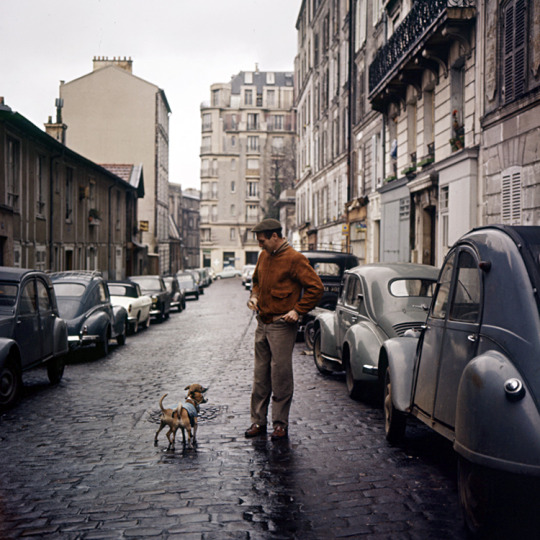
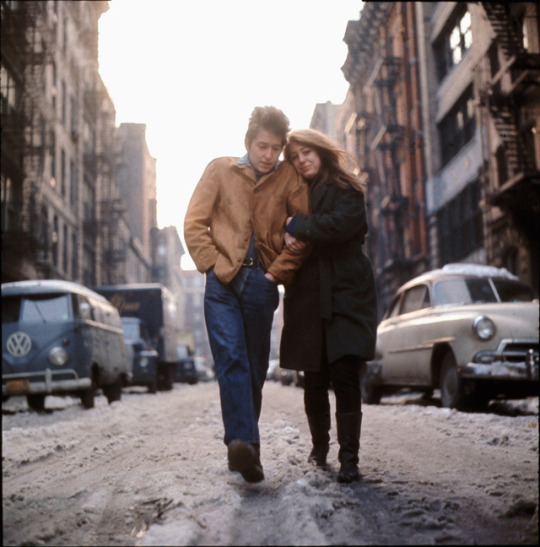
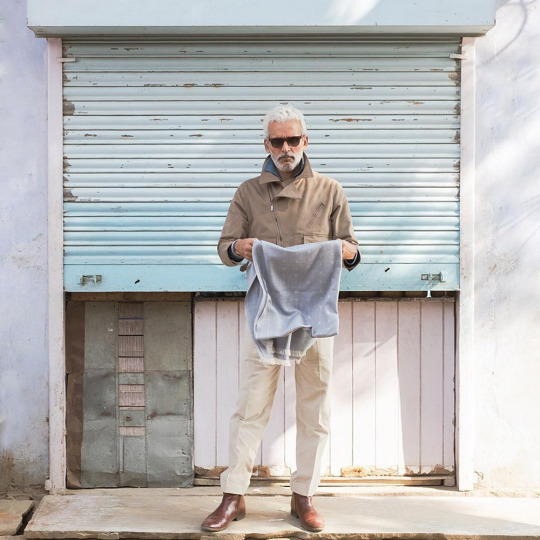
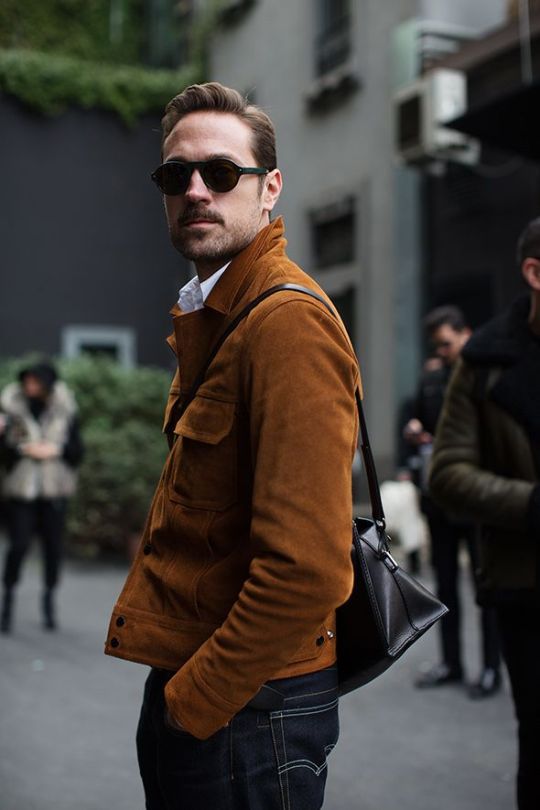
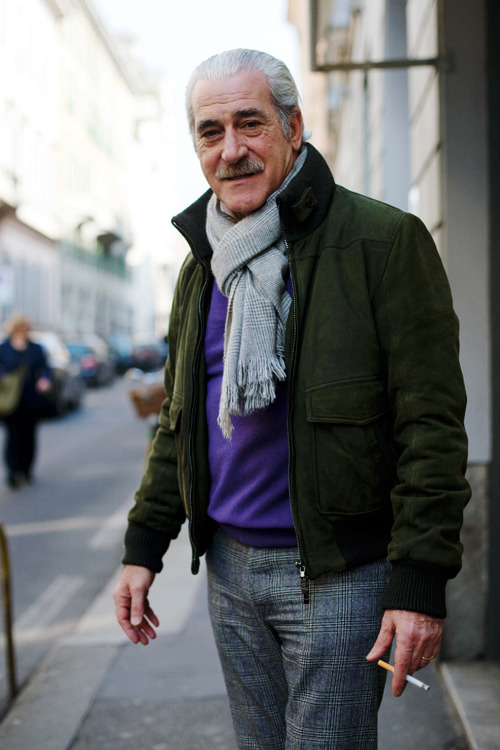
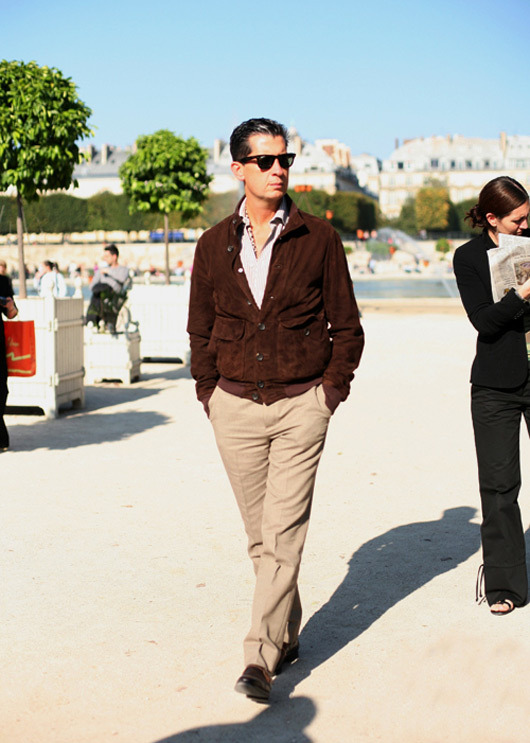


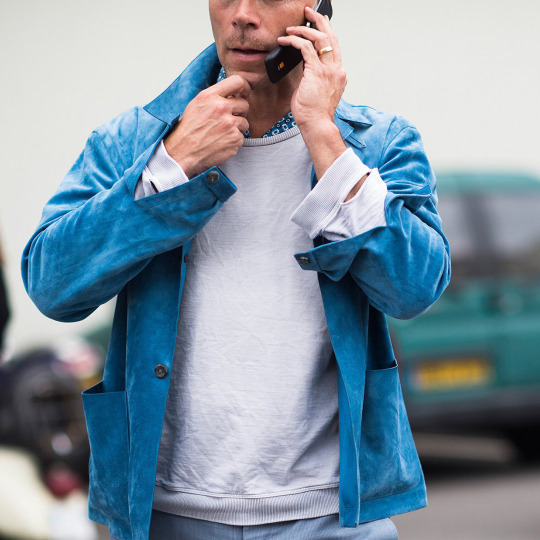

Easily Suede: The Softer Leather Jacket
The best clothes are often just as much about how the make you feel as how they make you look. And few things will make you feel more badass than a leather jacket. Over the years, they’ve become emblems of rebelliousness and black sheep individualism, thanks in part to style icons such as Marlon Brando and Sid Vicious. Whereas leather jackets started off in the early 20th century as functional garments that protected wearers from danger, by the end of the century, they were symbols that signaled the wearers were dangerous themselves.
Which is also what makes some guys shy away from them. Purchasing a leather jacket takes a bit of self reflection -- not just in terms of how can work with your wardrobe, but whether they really reflect your personality. “Am I leather jacket kind of guy?” Or “can I pull one off?”
I wrote a post three years ago breaking down leather jackets into three broad categories -- rugged, contemporary, and conservative. Those are good starting places, I think, for guys trying to figure out which styles work for them.
If you’re still feeling tepid, another solution is to start with something in suede, which is literally and figuratively the softer side of leather outerwear. Take even your most rebellious styles, such as black double riders, and they suddenly become more wearable if they’re built from napped leather. Less Hells Angel biker; more stylish dude in cool clothes.
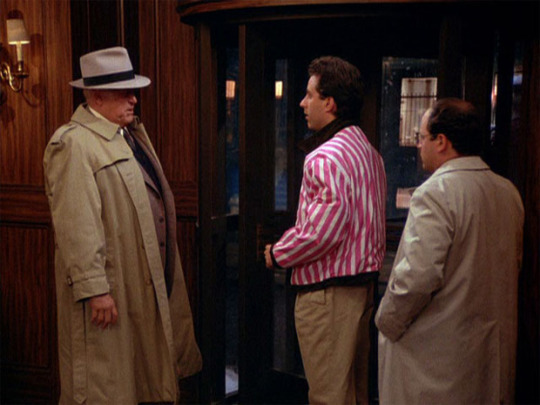
Care Considerations
Trading a traditional leather jacket for suede isn’t without its downsides. For one, suede is a lot harder to keep clean (which was the premise for this hilarious Seinfeld episode). Particularly in lighter colors, scuff marks and dirt will show up in high-fiction areas, such as the cuffs and collar. And should you be careful enough to avoid dirt, suede will still naturally lose its nap over time, which will leave a bit of a sheen.
There isn’t really much you can do about this, although some care techniques will keep your jacket looking its best. When you first get a suede jacket, consider treating it with a non-silicone-based waterproofer, which will help repel bigger stains (e.g. splatters from saucy burritos or coffee). Just be warned that sometimes waterproofers can clog up and “spit” onto your clothes, which will create their own marks (spray carefully and at your own risk). For superficial stains, you can also try spot cleaning with a suede eraser, brush, and specially formulated shampoo. Unscented baby wipes can also help keep things looking fresh.
Even the best care techniques, however, won’t prevent the inevitable, so the best solution is to get something you’re fine with aging. A rugged, dark brown suede jacket from Levi’s will fare better over the years than a dressier cream suede jacket from Loro Piana. And should something happen, you’ll want to bring your jacket to a high-end cleaner that knows how to work with leather. I’ve had great results through Rave FabriCARE, who will not only take out tough stains, but can also dip your jacket a special protective formula to prevent future issues. Other specialty cleaners include Modern Leather Goods and Superior Leather, although I have no direct experience with either. Just note: cleaning a suede jacket is expensive, so be prepared for some non-trivial costs.
Regular leathers will always be easier to maintain, but a suede jacket can be unique and easier to wear. If you’re up for trying something this season, here are seven models that will work across a range of wardrobes.
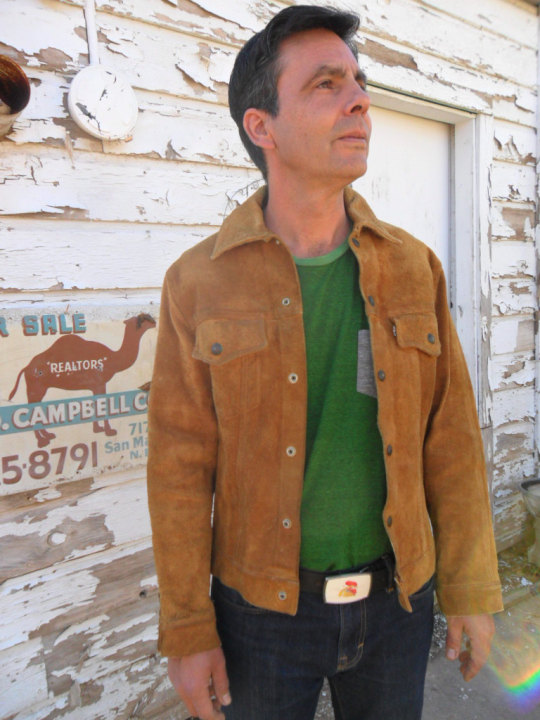
Levi’s Suede Trucker (~$350): For affordability, nothing beats Levi’s suede trucker jackets. The denim versions were originally made for laborers, but during the 1960s and ‘70s, they became part of American counterculture. The denim trucker jacket has been worn by hippies, rockers, activists, and bikers alike -- helping cement their status in classic American casualwear, much like five-pocket jeans and military surplus jackets.
Levi’s usually does their suede version in this goldenrod tan color you see above, along with a matching suede or contrasting dark brown leather collar. Brand new, they can run for a hefty $1,000, but they’re also not hard to find second-hand. The design has been around forever, so places such as Etsy and eBay are littered with vintage models for about $350. So long as the jacket doesn’t smell bad (again, leather can be expensive to clean), I think scuff marks here add character.
Alternatives: dark blue version from Jigsaw this season for $515 (although they’ll only deliver within Europe), as well as turquoise models from Levi’s Vintage Clothing and Gieves & Hawkes for a pricier ~$950. Sandro also has a handsome tan suede jacket for $995. More of a ranch style work jacket than trucker, but pretty similar.
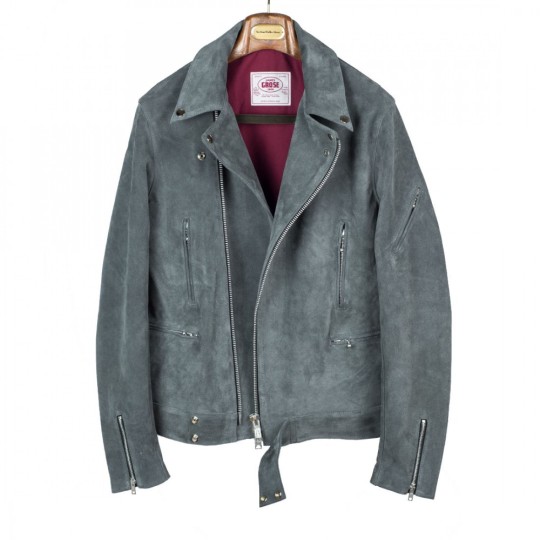
James Grose Double Rider ($868+): If you’ve ever questioned whether you have Marlon Brando’s smoldering good looks to pull off a Schott Perfecto, try this gray suede double rider from James Grose instead. They’re a recently revived British heritage brand, now run by a Japanese motorcycling enthusiast who has everything made in London’s East End. These jackets fit a bit slimmer than the workwear originals, and they comes with a bunch of great details, such as zippered arm pockets and extended belts. And despite them being clearly designed to be worn off a bike, the construction feels incredibly sturdy. The leathers are thick and heavy; the hardware reliable and chunky. Much like Levi’s trucker jackets, these look better with a bit of dirt and scuffing.
Even with its workwear vibe, you can embrace a slightly more contemporary look here by pairing the gray suede jacket with slim black jeans and a boxy white knit. If the gray double rider isn’t your speed, James Grose has a bunch of other colors and styles. And until tomorrow night, No Man Walks Alone is offering a 20% discount on all full-priced items with the checkout code SPRING20. That brings the price of these down to $868.
Alternatives: Gieves & Hawkes brown goatskin suede double rider for $1,275 and Stoffa’s asymmetric jackets for $1,300. Both will feel slightly dressier and less workwear-ish than James Grose’s jackets, which will allow you to wear them with finer knitwear and pressed trousers.

Valstarino ($796+): Although Valstar started off as a raincoat manufacturer, they’re mostly known today for their take on the classic A-1 blouson -- a type of flight jacket defined by its button front and stand-up, knitted collar. The A-1 was originally a military flight jacket worn by American fighter pilots until it was supplanted in WWII by the A-2 (which is what most people envision when they think of flight jackets).
Valstar’s A-1, known as the Valstarino, is the casual, civilian take, which makes this easier to wear in the city. They’re made from softer materials and come in a slimmer fit, while still maintaining that slightly rounded silhouette that I think makes these special. The style goes just as well with jeans as it does with dressier trousers, which is why Valstarinos have been popular for decades. You can find them these days at No Man Walks Alone, Mr. Porter, and Drake’s. No Man Walks Alone’s SPRING20 discount code brings the price down to $796 (again, code ends tomorrow night).
Alternatives: Craftsman Clothing can make you a custom, made-to-measure leather A-1 for $830. And while it’s technically not a bomber, this Brooks Brothers suede jacket looks similar and is on sale for $399.

Stoffa Flight Jacket ($1,500): I love Stoffa’s flight jacket for the same reason why I like the Valstarino. It’s easy to dress down with denim, but can also be used with wool trousers in lieu of a sport coat. The difference is that Stoffa’s design feels a bit bolder. The large, floppy collar looks great when popped up from the back, while the two-way zip gives you the ability to create more interesting silhouettes.
Stoffa’s flight jackets are also made-to-measure, which allows you to get a more tailored looking fit. The company has two other useful styles, including an asymmetric jacket that’s vaguely based off double riders and a field jacket for a more conservative look. All available in these uber-soft, lightweight suedes that make Stoffa especially comfortable in warmer climates. Only catch: since the jackets are all custom made, you can only order them at their trunk shows, although now they visit five major cities (Stockholm, London, Los Angeles, San Francisco, and NYC).
Alternatives: Gieves & Hawkes taupe suede bomber for $1,210 and Ralph Lauren Purple Label for a whooping $3,495.
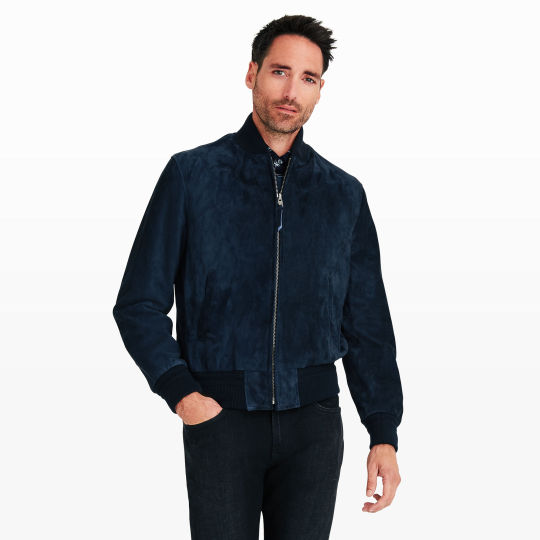
Golden Bear Varsity ($433): It feels like every label offers their version of a MA-1 bomber these days. Although the originals have bulkier, rounded silhouettes, fashion labels typically cut theirs to be much slimmer and straight fitting. The style is defined by its knitted collar, zippered front, and signature arm pocket. Although, when designers leave off the arm pocket and put in slashed hip pockets, these can feel a bit like varsities.
Both MA-1 and varsities are basic enough to work for almost anyone, but by the same token, they can also feel a bit generic. That said, for an affordable varsity, you can check out Golden Bear’s version shown above, which is on sale right now for $433 at Club Monaco. Epaulet is also moving their boutique this month from NYC to Los Angeles, and in doing so, they’ve discounted their suede MA-1 bombers down to $325.
Alternatives: Basically everyone and their mother. Check APC ($1,455), Presidents ($1,723), Brooks Brothers ($698), AMI ($1,385), Officine Generale ($1,320), and Rag & Bone ($1,295).
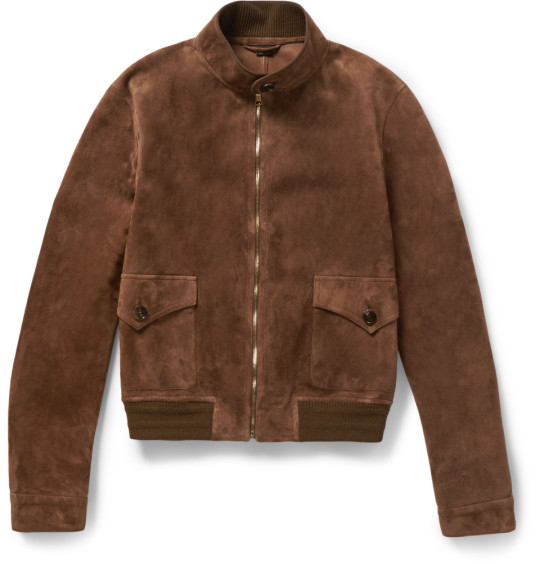
Gucci Harrington ($3,390): Once part of the uniform of British working-class youths – such as mid-century mods, skins, and soul boys, all the way up to the Britpop scene of the 1990s – Harringtons feel a lot tamer these days. More aligned with their Ivy Style roots than the British streetwear scene that gave them their edge. I like Gucci’s suede Harrington because it’s still somewhat conservative, but has a taller collar and slightly cropped body, which I think helps steer this away from golfing-dad territory. It would look great with slim trousers and a boldly printed silk shirt.
The other thing that keeps this away from dad territory is the exorbitant price, which nobody would pay if they’ve ever had to manage family expenses. A jacket for financially reckless, single guys only.
Alternatives: This Harrington from an old season of Saint Laurent is similar -- slightly cropped, boxy fit with a taller collar. You’ll have to scour eBay and Grailed for it, however, since it’s no longer for sale in-store (expect to pay somewhere in the neighborhood of $2,000). For a much more conservative and affordable jacket, Brooks Brothers has a traditional Harrington for $698.
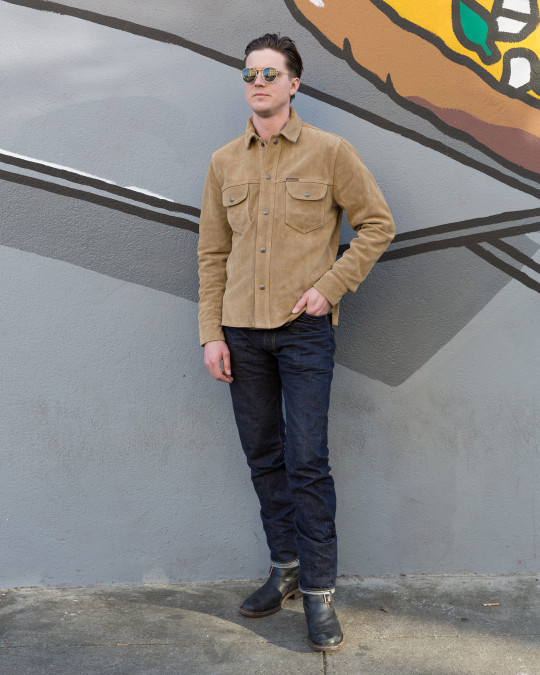
Indigofera Suede Shirt Jacket ($899): Indigofera’s suede shirt jacket is what I’d wear if I were a burly dude with a beard, or someone with rugged good looks, such as the model above. It’s a heavy, rough suede jacket with a very simple, shirt-like cut. The subtle Western-style stitching across the pockets gives this a slight cowboy vibe. Would look great worn open over a white t-shirt, along with raw denim jeans and either engineer boots or service boots. The tan color here will show marks easily, but like Levi’s and James Grose’s jackets, this will look better with heavy wear.
Alternatives: Billy Reid makes a charcoal jacket in a similar style for $995. For something a little less workwear-ish and more ‘70s casual, check out Our Legacy’s lighter weight zip-front jacket for $554.
51 notes
·
View notes
Text
Mikethemod’s Brighton Marathon Prep.
Saturday was the highlight of my week. Our best friends Debbie and Andy Harris, AKA Bootleg Blondie, decided they were going to take Dawn and me, AKA mikethemod, on film location in Brighton. I didn’t have the heart to tell them about my potential hernia as I knew they were looking forward to our day out!
When we got up at 7am on Saturday it was raining so Dawn gave me grief about her hair going curly. And it was still raining when Deb and Andy arrived at 10am in the Bootleg Blondie Van. This is a real Rock n Roll van divided into two sections - half for band members to travel in (famous musicians have signed the interior walls) - and the other half to transport whatever.
It was then that we discovered the scooter wouldn’t fit in the back of the van. This wasn’t a good start. As I stood there looking helpless Andy came to the rescue by producing a large leather bag of tools from nowhere and sent me into my garage to search for some wing nuts. It was a scene that many real scooterists - including myself - have endured far too many times; we were both kneeling on the wet road in the pouring rain trying to undo bolts that were stuck fast.
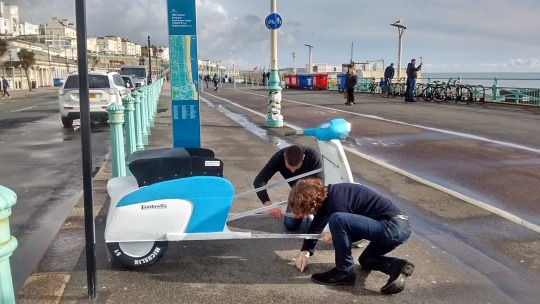
Half an hour later we were sorted, phew, and the four of us, plus a dismantled leg-powered Lambretta, were finally en route to Brighton. Our first stop was Preston Park. This is where the masses start the Brighton Marathon race and is also the home of the famous Steve Ovett statue - or so I thought.
At this point I need to backtrack a little…. last year a PWR colleague told me he was on the Elite Start, at Withdean Park on the London Road, as he had run a good time in the Boston Marathon. I ran the Phoenix AC relays many years ago (Steve Ovett was on the same start line) – and I remembered that Withdean Park was flat. This appealed.
I wrote a polite email to the organisers telling them my best half-marathon time and asked if I could be on the Elite Start with my training friend. By the time I attended the Brighton Expo with Dawn to collect my number, I had been accepted on the Elite Start. Yes. We had a celebratory veggie lunch afterwards at Terre Terre.
Back to the present….. Andy skillfully manoeuvred his van along a narrow road up the side of Preston Park but I couldn’t see the statue of my hero Steve Ovett. A hasty Google informed us poor Steve had been cut down and stolen 10 years ago in 2007. Is nothing sacred?! Then we read that Steve had been remade (hurray!) and unveiled in 2012 on Madeira Drive by the Brighton Marathon Finish line - and the Volks Bar, home to any journeying Scooterist - double delight. Andy reset the Satnav and we soon got our first glimpse of the sea.
Our second stop was the loos on Madeira Drive. These are always well looked after but bloody freezing. Last time I was there I couldn’t climb off my scooter quick enough - after two hours spent clinging onto my 50 year old Lambretta I severely regretted wearing button fly Levis 501s.
Loo stop completed, our third stop was a parking bay where we deposited more coins than the Hatton Garden raiders lifted, to pay for just one hour’s parking. And there, in fine fettle and surveying the open sea, was my man Steve Ovett. His majestic running style was perfectly captured; big chest, arms barrelling round, hands soft and relaxed.
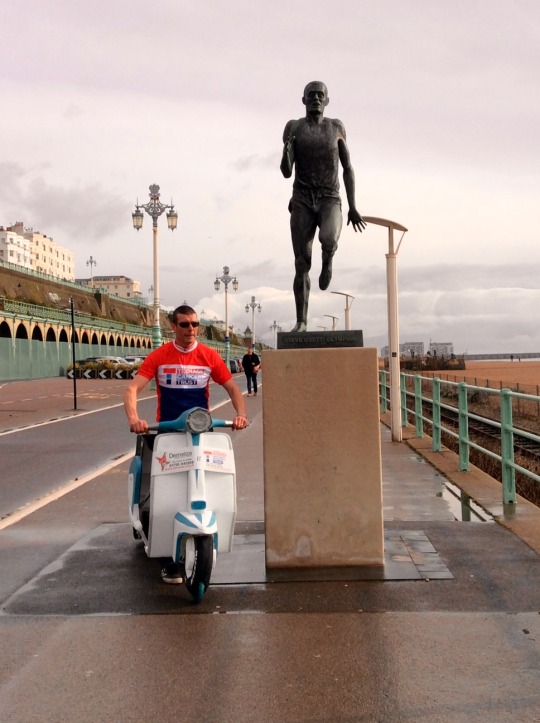
Dawn and Debbie were our costume and film crew and Andy was our Director. Cue - photo of mikethemod in Parka and Tootal scarf with Steve, photo of mikethemod in Teenage Cancer Trust Mod-style cycling shirt with Steve, photo of mikethemod in Demelza Hospice Care for Children Mod-style cycling shirt with Steve. Action - film of mikethemod in Parka running up and down, film of mikethemod in Teenage Cancer Trust Mod-style cycling shirt, etc etc, …..you get the drift.
During filming a guy in a disability car drove along the road and gave us a wave. This was an opportunity too good miss. With the Director waving his arms around, Mikethemod sprung into action and a Benny Hill-style epic was in the bag. Oh yes.
Our fourth stop was near the 7-mile point on the Brighton Marathon course, offering stunning views over the cliffs. With the sun glinting off the English Channel, Director Andy and I immediately had the same idea and Mikethemod - in his various guises - was soon running east and west along the cliff edge with the wind blowing, the sea breaking below and the Who’s ‘I’ve had enough’ playing in our heads.

After all this emotion, mikethemod, the film crew and the Director were in need of a restorative cuppa. On the road leading back into Brighton we discovered a 50s-looking café above the Marina named the Roedean Café - what a jewel, our fifth stop. With fantastic views over Brighton Marina and some delicious-looking food being served to locals, we enjoyed three perfect latte coffees and one Earl Grey tea.
Sixth stop the beach. I just couldn’t help myself. Marching over the stones carrying my polystyrene Lambretta, I went right to the sea’s edge and sat down. Wrapped in my Parka, I was ‘Jimmy’. The film crew got to work and took some impressive shots with Brighton Pier as our backdrop. After a few more photos at the front of the pier and by two Blondie-esque red telephone boxes, we were back in the van heading to our seventh stop - the Grand Hotel.
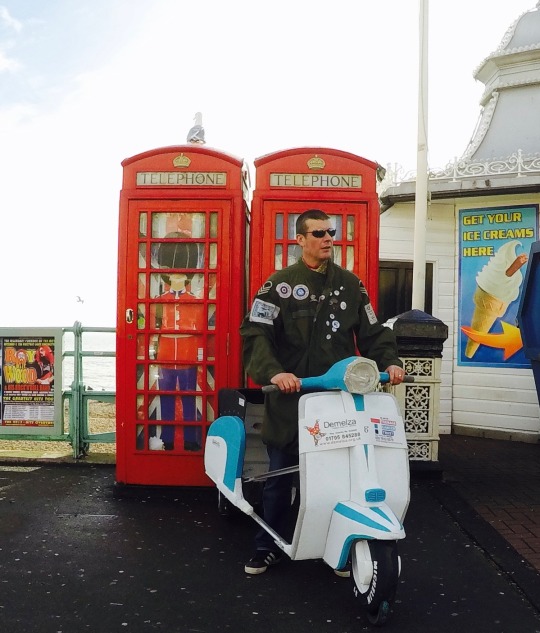
Andy parked up on the seafront and I ran over to the hotel to explain that mikethemod was fundraising for Teenage Cancer Trust and Demelza and we would like to take some photos outside the Grand Hotel. The Concierge Team could not have been more helpful. They allowed us to park our van right on the hotel forecourt and their fantastically professional Concierge ‘Paf’ - complete with top hat and tailcoat - ensured we got some great pics. I did think it was funny that one of the team said he never knew why some people walked past the hotel shouting ‘Bell Boy’! I advised him to go straight home and watch Sting in Quadrophenia.
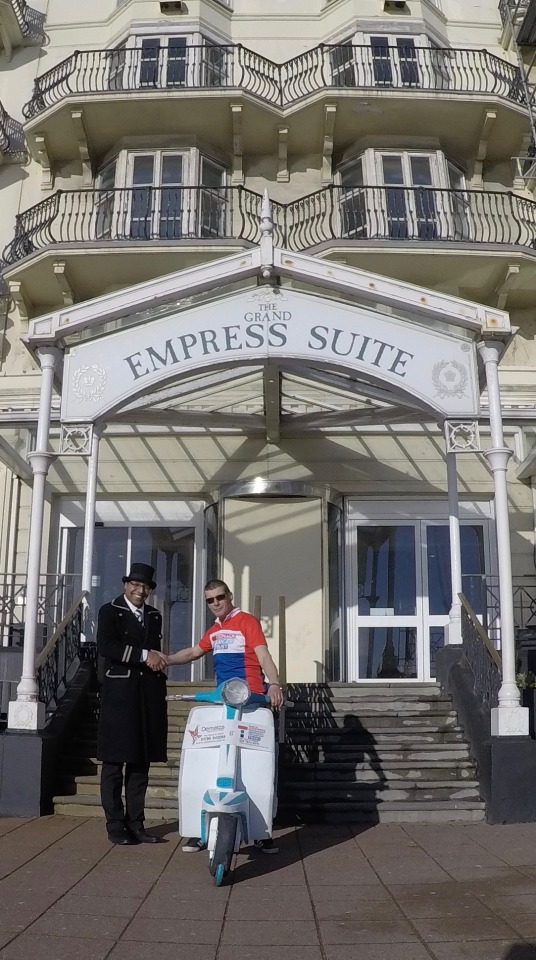
By now we were tired and hungry (mainly me) but we had two more stops to go. In fact we stumbled across our eighth stop while looking for a parking place in or around ‘The Lanes’. Andy stopped the van to let a car pass and beside me to my left was a tiny lane disappearing behind a shop. “That’s it” I said - East Street’s Alleyway where Jimmy ‘hid’ with Steph (Leslie Ash) as the fighting Mods and Rockers were chased by the police. Jimmy and Steph actually did a little bit more than just hiding in this alley.
Andy put the hazards on, Dawn guarded the van on a yellow line and we quickly ran down the alley. In a tiny corner there was a door covered in scooter club stickers and mod patches. Hilarious - someone had scrawled ‘mikethemod’ on the wall! I am a celeb you know. We had a laugh taking pics in various poses and then dashed back to the van.
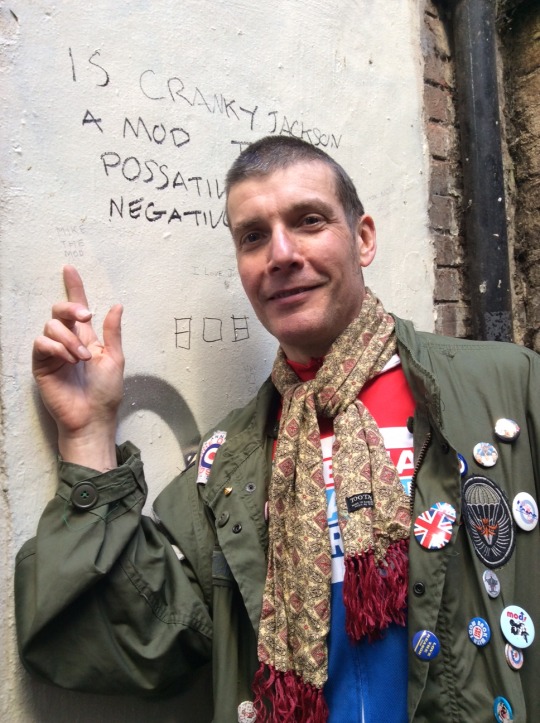
Ninth stop - the Mod shop Jump The Gun in the North Lanes. I had been there some months before to tell them about my project but got short shrift. Unfortunately they weren’t enamoured to see us again and, despite mikethemod and his scooter drawing a small crowd outside their shop, all they could do was tell us we were in the way of the door.
Tenth and last stop - fish and chips. The Palm Court restaurant on Brighton Pier is one of the town’s quality food venues. A year ago I booked tables for 50 Petts Wood Runners after we ran the Brighton 10k and we were all impressed with the quality of the food served here.
With its location at the end of the pier offering fine views out to sea and along Brighton’s coast, you may expect the Palm Court to rest on its laurels and be an expensive low-quality tourist trap. It most definitely isn’t. Dawn had a perfectly-baked salmon Debbie and Andy chose tasty vegetarian lasagnas and I went for the ‘Big Fish’, a 12oz cod loin - fantastic. Our food was fresh and hot, the service was friendly and efficient and the restaurant was smart and clean.
Outside the sun was now setting on the horizon and we watched a huge black mass of starlings dance over the sea in liquid formation. Although we were full, we couldn’t resist the aroma coming from the doughnut kiosk so we bought a bag of four piping hot sugar-covered doughnuts (I am carbo-loading you know) and ate them on the way back to the van. A great day. Now home to find out what goodies were captured inside our collection of cameras.
#brighton#brighton marathon#mikethemod#mike the mod#petts wood#petts wood runners#marathon training#scooters#lambretta#mods#quadrophenia#the who#terre terre#brighton Pier#palm court restaurant#roedean cafe#roedean#the grand hotel#paf concierge#madiera drive#brighton argus#teenage cancer trust#demelza hospice#tct#concierge
1 note
·
View note
Photo

GCOP200 - Teddy Boys & Haul Girls - Week 1 & 2
Due to this series of lectures being interrupted by the Lacock Abbey trip, the reflection session for both lectures was summed up in one lecture, so I shall cover both GCOP lectures here.
This series was to comment on subcultures, their origins, where subcultures exist now and the theory behind subcultures. The lecture was heavily biased towards the U.K end of the subculture spectrum, with the advent of Teddy Boys in the 1950′s being influenced by the American culture of the time. This was also the time when the ‘teenager’ was coming of age - a new era of money, freedom and tastes. There is an almost anti-establishment sentiment to subcultures from the get go, almost seemingly created not just to fit into a certain social class, but to stick the middle finger to the man, with each subculture having a sensationalist element to it, which in term makes it shocking. Often this sensationalist element was the clothing they wore, made in total to just stand out.
Yet another Marxist trope is ‘Dominant Ideology’. Which in the layman is the everyday aspects of life which is expected from a society. Subcultures in term, go against this and revolt against the Dominant Ideology. But paradoxically, the subcultures create their own Dominant Ideology within their separate groups, with other subcultures revolting that like a subculture mitosis. But, this is where subcultures are inherently related. They are all connected in some way or another, and they are all categorised groups of people wanting to fit within a certain group, which ultimately they grow out of.
But do subcultures exist today? In short, yes. But nowadays, they are extremely niche or even sporadic. There are entire subcultures within fashion, whether that’s street core, norm core, health goth or anything else you could find on /fa/. Whilst Millennials are blamed for everything, including the death of subcultures, they are usually the one’s populating these cultures, and internet subcultures. The terms digital immigrants and digital natives was explained within the lecture. This means, one either was born into a world before computers or born into a world and not knowing anything else. For me, I can remember a time before getting a computer and getting our first computer. All of Generation Z would be counted as digital natives, as they were born into a world already populated with this kind of technology. I for one count myself as a late Millennial (born 1995) and remember a time before computers entered the home in around 2001. This age of digitalized subcultures has created things such as filter bubbles and ‘blocking culture’. Filter bubbles is basically algorithmic changes within ones internet interests and views. If one is right wing on Twitter, they are only going to see content from that point of view, and rarely content from the left wing - keeping them inside of a bubble of their own information, which could if certainly caused the Brexit dumpster fire. And, if one disagrees or speaks above those views, they are blocked and forgotten about - silenced.
The internet has also created subcultures as Vaporwave - a subculture I have delved into before. Vaporwave is the reproduction of old and irrelavant music such as muzak and esoteric genres, that’s been slowed down and altered to create a surreal musical experience. It is also a take on anti-capitalism, albeit a comical take on it and being born from it. The artwork is bombastic neon colours mixed with Greek art and tile patterns - creating a whole new world of surrealist utopia. But, are we living in a utopia?
Utopia and Dystopia was thrown into the mix, with the question: can a utopia exist? This perfectly fits into my work as it documents the banality of modern existence. I firmly believe that we live in a Dystopia, fictitiously disguised as a Utopia. Our world is made out to be this incredible land of freewill and freedom, but we are really shackled to monetary systems, dead end occupations and polluted waters. We are surveyed 24/7, with every move being looked upon, and our decisions aren’t our own and rather informed by massive conglomerates making our minds on what to buy. We can think that we live in a Utopia, but you’re kidding yourself. There are people trying to fight this with’ Buy Nothing Day’, which I feel is rather pointless are people are so controlled by Capitalism, that they’ll ‘revolt’ against the system for a day and go back to it the next day - is it really all in vain? Futile?

Art was often used to shock the masses - create a ruckus to gain attention and traction for the work. Art used to create a stir amongst it’s ecosystem, but I would argue that it doesn’t anymore; becoming a blase attempt at creating work just to shock, if nothing else. There has been so much work created to shock, that it’s novelty has worn off, become an occurrence that goes within caring. This can be linked to the Modernist Avant-Garde, wanting to shock the Bourgeoisie by creating work aimed towards that goal. But, since shock has been used so much in the arts culture, the effect of it can no longer work as so much has already been used - in short, the shock quota has ran out and no longer works. Leaving the EU and a bankrupt billionaire is POTUS are daily headlines, and tabloids have become self-satirising. Why have Brass Eye in 2018 when we live it?
Dadaism is an example of shock used in art. Usually created with cut out’s of printed images, with the usual ethos of spitting onto issues such a Nationalism and Materialism, but wanting to be non-art as society has heading towards nothingness.
The Punk movement was surely the head of the subcultures. An amalgamation of past subcultures, created and manifested by designers and antidisestablishmentarianism. Subcultures, are then entirely lead by fashion. Teddy Boys had suits and slicked back hair, Rockers wore jeans and leather jackets, Mods wore parkas and rode Lambrettas. Subcultures, are then just manifestations of people with similar fashion choices and the need to be in a social group, and to be accepted within a certain culture. Subcultures then inform areas of contemporary visual culture and then feed into other areas and subcultures once again.
A coda. Subcultures have manifested with the rise of the teenager, and mainly form as fashionista teenagers who want to be accepted. The internet age hasn’t completely killed these subcultures, they’ve just moved to the internet and created niche and bombastic ethos’, with the realisation that modern life is just a dystopian novel, and we are the protagonists. The art was has also (to me at least) has lost it’s shocking edge. Whist artists nail their scrotum’s to the Red Square, it could all be a futile attempt at notifying people to a country’s issues or a painful attempt at shock for the sake of shock. I not one for heavily political/shocking art, as it comes across a blase and crass to such a person who’s views on art is often jaded.
This marks the end of this series, and our lectures with Alanna. Whilst some lectures were laborious Price history lessons, they certainly opened my eyes to certain areas I never considered. I now look forward to the next lecturer and series of lectures.
Tasks
Bricolage Items -
Subculture Artist -
Create Your Own Utopia - What does my personal utopia look like? An ideal world that I could envisage into a bricolage of ideas. Firstly, entire city centres would be adorned with Brutalist architecture, as far as the eye could see. Tungsten lights would glow in the night as the torrential rain pours down onto the metropolis, with the streets filled with transportation and the streets bustle with the city’s occupants. I’m fairly certain the my utopia is Ridley Scott’s Blade Runner.
LSN Report - The report talks about South African teenagers and their subcultures or ‘Post subculture movement’: Bubblegum Club. They want to be seen and noticed. They express themselves with music and dance, and consuming popular culture and living in popular culture. And within this subculture, they value freedom and for what their previous generations fought for - without the previous generations fighting for freedom, they wouldn’t be doing what they are doing. And this can be taken, certainly into the western world. Our troops fought for what they thought was right (despite a lot of them not fighting at all). This subculture isn’t just a for social activities, but for them it’s their way of living in their society. Which is the same wherever you go where there are subcultures - it’s their way of living.
How can this be applied to me and my area of study? I am not entirely sure that it does. I do not identify with a particular group or culture, as I feel that being a white straight male in a western society, our culture is just an amalgamation of all cultures. And this is where the issue of white people claiming ‘cultural appropriation’ on things such as people with dreads being linked to the Caribbean, despite most cultures throughout history wearing deadlocks at some point in time, including the Vikings and the Romans....who were white. But honestly, I don’t feel as if I can comment on being in a subculture, when our society is created by many thousands of historical elements and subcultures.
Bibliography
Knottyboy.com. (2018). History and Origin of Dreads | Knotty Boy. [online] Available at: https://www.knottyboy.com/learn/dreadlock-history/ [Accessed 17 Nov. 2018].
0 notes
Link
Dotted around London, these 13 tiny green sheds are reserved for those with ‘The Knowledge’.
By Ella Buchan
1 May 2018
“We’re a Victorian institution,” black-cab driver Henry announced proudly, tugging on his tartan cap. It was a grey mid-morning in London and I was squeezed in a small green shed behind a narrow, U-shaped table. Surrounding me were a cluster of taxi drivers who slurped on mugs of tea and shovelled in forkfuls of scrambled egg and sausage.
This diminutive shed in Russell Square is where the keepers of London’s secrets gather – the black-cab drivers whose minds are mapped with every inch of the city. It’s one of 13 cabmen’s shelters remaining in the capital, and only licensed drivers who have passed The Knowledge test – memorising every street, landmark and route in London – are allowed inside.
View image of Thirteen historical cabmen’s shelters can be found throughout London (Credit: Credit: Chris J Ratcliff/Getty Images)
The idea for the shelters came in the late 19th Century when George Armstrong, a year before he became editor of The Globe newspaper, was unable to hail a taxi during a blizzard because the drivers, who then rode horse-drawn hansom cabs, were huddled in a nearby pub. He teamed up with philanthropists, including the Earl of Shaftesbury, to find a way to keep drivers on the straight and narrow – and off the drink.
The Cabmen’s Shelter Fund was born in 1875, building the first hut in St John’s Wood. It still operates today, though many of the further 60 huts built have since been knocked down.
This is where the keepers of London’s secrets gather
Each hut was built no bigger than a horse and cart, in line with Metropolitan Police rules because they stood on public highways. They provided shelter and sustenance for hackney-carriage (black-cab) drivers, with strict rules against swearing, gaming, gambling and drinking alcohol.
Then came World War I. Drivers and their vehicles were drafted, plunging the cab trade – and the shelters – into decline. “We lost people, cars and horses,” said Gary, one of the cabbies I chatted to at Russell Square.
Unused, unloved and unprotected, the oak huts suffered rot and ruin. Some were destroyed by bombs during World War II, while many were later bulldozed in street-widening schemes.
View image of Built in the late 19th and early 20th Centuries, the green huts provided shelter for the city’s hackney-carriage drivers (Credit: Credit: Edward Gooch/Getty Images)
Now just 13 remain, with 10 in operation. Each is Grade II listed, which means they are considered buildings of special interest and every effort should be made to preserve them. They are owned by the Worshipful Company of Hackney Carriage Drivers (WCHCD), a guild for those who earn their living through the trade. The Cabmen’s Shelter Fund is responsible for upkeep and maintenance, issuing annual licences to those who run them.
“The cab trade is very lonely,” said Colin Evans, a cabbie of 44 years and trustee of the fund. “These are places where you can go and have a tea or coffee with your mates. If drivers don’t support them, they will be lost forever.”
Gary, who often comes here for a tea and a grumble because “everyone’s in the same boat”, added: “I’ve been driving a cab for more than a few years and only recently started using the shelters. I decided, use them or lose them.”
View image of The cabmen’s shelters are no larger than a horse and cart, and only drivers are allowed in (Credit: Credit: Chris J Ratcliff/Getty Images)
Most serve breakfast (sausages, eggs, bacon), sandwiches and hot drinks, with the occasional pie or lasagne cooked by the owners at home and reheated in the skinny kitchens. Non-cabbies aren’t allowed to sit inside – unless issued with a rare invitation – but can order through a window hatch.
“We bring in more money that way,” said Jude Holmes, who runs the kitchen at Russell Square. “I can serve hundreds of people while a driver sits with one cup of tea.”
It’s like their second home
As we sat there, a relentless drizzle outside drew more cabbies through the door, each greeting the others like family members.
“My little gang comes in every day,” Holmes said. “I worry a bit if I don’t see them. It’s like their second home. Sometimes they even make their own tea.” She added that newer drivers are often too intimidated to come inside, preferring to order bacon sandwiches at the window.
“It can feel a bit cliquey at times,” Gary admitted.
View image of Card playing and gambling are prohibited inside London's cabmen's shelters (Credit: Credit: Ella Buchan)
The kettle bubbled, teaspoons clinked against china, and bacon spluttered and sizzled in a pan as talk turned to the cabbies’ biggest bugbears. Being ‘bilked’, for example, when a fare runs off without paying. Struggling to find a public lavatory when on the job is another common groan (the shelters don’t have loos).
Most drivers have other gigs, as musicians, artists, TV producers, even actors. But, they told me, once a cabbie – always a cabbie. “If you retire, you die,” Gary deadpanned.
The anecdotes poured faster than the tea. There’s the tale of ‘Fat Ray’, so huge he squeezes himself behind the wheel each morning and doesn’t budge until he gets home. “He couldn’t come in ’ere,” said Henry, sweeping his hand around the shelter. “He’d never fit through the door!”
View image of Most cabmen’s shelters serve breakfast, sandwiches and hot drinks (Credit: Credit: Chris J Ratcliff/Getty Images)
Evans took me for a spin in his cab, stopping by Temple Place shelter on Victoria Embankment, where a team was fixing damage caused by a lorry.
The shelters’ Grade II status means restoration is intricate and expensive. Refurbishment costs around £30,000, Evans estimated, and replacement materials must match the originals. Even the shade of paint – Dulux Buckingham Paradise 1 Green – is prescribed to mirror the first huts.
They represent a moment in time
Shelters have also been hit by noise restrictions in residential areas, and none currently operate at night – most open around 7:00 and close by 13:00. A hut at Chelsea Embankment has been closed for five years due to parking restrictions, and the fund is considering donating it to the London Transport Museum.
Crucially, said Evans, these tiny huts must not disappear – nor should their history be forgotten. “It’s too easy to get rid of these things. The shelters are unique. They represent a moment in time.”
View image of Jude Holmes also sells snacks to the public through the hatch of the Russell Square shelter (Credit: Credit: Ella Buchan)
It’s true there’s plenty of history packed within their walls. Evans told me that the Gloucester Road shelter was nicknamed ‘The Kremlin’ because it was frequented by left-wing drivers. The since-bulldozed Piccadilly hut was the site of Champagne-fuelled parties in the 1920s and dubbed the ‘Junior Turf Club’ – after an exclusive gentlemen’s club nearby – by (non cab-driver) aristocratic revellers who smuggled in booze.
And according to local legend, a man claiming to be Jack the Ripper once visited Westbourne Grove Shelter.
Physical signs of their history remain. Tenders attached to the bottom of the huts were where drivers tethered their horses before going inside. The animals drank from marble troughs, now gone. Each shelter still has a rooftop vent with ornate carvings – reminders of the wood-burning stoves once used for heating and cooking.
View image of In the Warwick Avenue shelter, shelves are lined with cabbies’ mugs bearing the names of their football teams (Credit: Credit: Ella Buchan)
We continued onto Warwick Avenue shelter, frequented by musicians and actors who live nearby. British mod-rocker Paul Weller, former lead singer of The Jam and The Style Council, often comes to the hatch for a sausage-and-egg sandwich, licensee Tracy Tucker told me.
Tucker, whose husband is a cabbie, has been a shelter keeper for 14 years, moving to this location from Thurloe Place in 2016. The roof was recently re-shingled at a cost of £13,000, financed by the fund.
Inside, the tiny kitchen has a stovetop sizzling with sausages and bacon, a fridge stocked with sandwich fillings and shelves heaving with cabbies’ mugs bearing the crests of their football teams. When someone’s team is relegated or loses a big match, Tucker ties a black ribbon to their mug’s handle in commiseration.
View image of Tracy Tucker, who runs the Warwick Avenue shelter, sees her regulars as family (Credit: Credit: Ella Buchan)
To her regulars, Tucker is family.
“They see me as a big sister,” she said. “If I’m sick, I have to text about 20 people to say the shelter is closed. Some of them won’t know what to do with themselves.”
If we lose this, we lose part of London history
She has her own rules: no staring at mobile phones and no moaning about Uber. “We all know it’s quiet. The trade is dying, and I have thought about what I would do if I had to get another job. I don’t think I could work anywhere else.”
“The little lives that go on in these shelters,” chuckled Evans as we pulled away. “It’s not just the buildings. It’s the characters, too. If we lose this, we lose part of the cab trade’s history and a part of London history. That would be a real shame.”
Join more than three million BBC Travel fans by liking us on Facebook, or follow us on Twitter and Instagram.
If you liked this story, sign up for the weekly bbc.com features newsletter called "If You Only Read 6 Things This Week". A handpicked selection of stories from BBC Travel, Capital, Culture, Earth and Future, delivered to your inbox every Friday.
from bbc.com/travel/columns/adventure-experience
The post What’s in London’s secret green huts? appeared first on Travel World Network.
0 notes
Text
Mercury Cyclone Spoiler II That Got Its Owner Into the 150mph Club At Bonneville
Michael Callahan from Cincinnati, Ohio, always dreamed about going to Bonneville with a street car and getting into the 150MPH Club. Or should we say, drive a car to Bonneville, make his passes, and then drive home. A few years ago he got into the 130MPH Club with a 1999 Ford Crown Vic that was a Bondurant Driving School car set up by Jack Roush with a 1999 Mustang Cobra valve train. He got into the club with it, but he knew it couldn’t go 150mph, and you know that higher speeds are addicting. After he retired from the printing business the search for a 150mph street car commenced. He wasn’t after any specific car, with his parameters being for something he could easily modify aerodynamically, and performance-wise too. In 2015 he found the car he thought would work for sale in California, this 1969 Mercury Cyclone Spoiler II. It hit him that this would be the perfect type of production car to make an attempt for his dream.
Cyclone Spoiler IIs were originally made to fight the aero wars in NASCAR, where a 500-production run available to the general public was necessary to homologate the cars for racing. In all 503 were said to have been built, all with 351 Windsor engines, C4 automatics, and all painted white with either blue or red accents. What made it such a perfect Bonneville car was the factory aero aids almost hidden from a standard Cyclone. The noses were extended about six-inches and lowered, and a flush grille was added. Ford Torino Talladegas were built in a similar fashion. The front bumpers were modified rear bumpers, V’d in the center, and capped to help aero. Also, the rockers were modified to roll into the frame higher; to cheat the NASCAR rules stating stock ride heights determined minimum racing heights. NASCAR measured at the rockers, so if they are higher the car can be lower, for a lower center of gravity and better aero. Get it?
Rumors over the years have speculated that actually only 351 Cyclone Spoiler IIs were built, and that Mercury assembled “503” Spoiler IIs as verification for NASCAR, with the cars further back of the assemblage actually being standard Wimbleton White Cyclones. Supposedly NASCAR didn’t notice the difference when doing a quick count.
What Michael got when he bought the Merc was a modified Spoiler, set up basically like you see it here. Painted a non-stock black, it also has a 1970 stock block 351ci Cleveland with 4bbl heads and single 750 Holley, hooked to a wide ratio Top Loader 4-speed trans. Out back a 2.75 Detroit Locker rear also got Michael a few steps closer to Bonneville. So the mods and improvements sealed the deal and he drove it home from Torrance, California, with a list of things to fix with every mile driven. Over the last two years of ownership Michael has made substantial small fixes and improvements to ready the car for its salt assault, but the mods made by previous owners proved to be well executed, saving Michael both time and money from his original plan to change out the engine and driveline for something more substantial. He lucked out.
Some ply the salt of Bonneville to build a better mousetrap in any number of classes to break that category’s top speed, and the pride and sense of accomplishment that goes with beating a standing record. But you can also choose to achieve a personal best by picking a speed and then attempting to hit it. No categories, no record breaking attempts, just setting a series of parameters and then pursuing your own private conquest. For Michael that meant driving to Bonneville, hopefully exceeding the 150mph magic mark, and then driving home. Speeds are determined by making a pass on the 2½ mile course, then making a return pass within a certain time, and averaging the two speeds.
Michael’s changes to meet SCTA specs to race the course included a 4-point roll bar, driveshaft loop, V-rated tires, 5-point harness and seat brace, and a handful of other additions. When he put it on a chassis dyno a few other changes were deemed necessary to surpass 150mph at Bonneville. Beehive valve springs with titanium retainers were added, an Edelbrock air-gap intake replaced the single plane manifold, 16-inch rear wheels were added to gain speed, an aluminum driveshaft replaced the clunky original, and many minor changes were made to the Holley. But keep in mind that this car runs a mechanical fuel pump, stock pistons, rods and bottom end. With those changes the Merc ran 168mph simulated on the chassis dyno at 5900rpm.
As for the car’s road manners, it’s been driven thousands of mile to different events including the Aero Warriors event in Talladega, Alabama. It’s tight, squeak free, and surprisingly docile on the open highway and around town. No bump and clang, squeaky urethane suspension, or microwave interior manners. It’s that perfect combo of sitting right, looking and performing well, and 4-speed fun to drive.
After all of the thrashing to prepare it for its maiden runs on the salt the 2015 Bonneville meet was rained out, so the wait began for 2016. When it finally arrived Michael drove the Spoiler 1800 miles to Bonneville. Getting there for Tech Day, he passed tech and the next day ran 154mph on his first pass, with a backup pass of 153mph, making it into the 150MPH Club no problem. This was done with windshield wipers and side mirrors, the tune he drove it to Bonneville with, and a mix of 91 octane gas the car had for the trip to Utah, and some 100 octane gas he picked up on the course. He told us the passes were exhilarating, except for the skating on the salt surface as speeds increased. For that you need some mental and physical restraint. If you don’t back off and don’t over correct, you’re positioned to complete the pass short of breaking a part. Backing off or slowing down induces the car to swap ends. If you turn the steering wheel too much one way or the other to try to correct for the skating, you can also swap ends or lose control. Your best reaction is to stay on the gas, and read the feedback the car gives to determine whether you need to correct steering or just forge ahead. Michael settled in and forged.
When he’s telling the story it seems so simple; just drive your street car to Bonneville from Cincy, go 150mph, and then drive home. Of course we know that any effort like this required plenty of planning, thought, time and money. Still, Michael got into the Cyclone really reasonably, and though he expected he might have to rebuild the engine and do other major mods, it ended up being one of those happy ending stories that greased the skids to fulfilling one of the most improbable dreams a hot rod enthusiast could have. Congrats to Michael and to his murdered out Cyclone Spoiler II.
Deception and speed were what led to the limited production, wind cheating 1969 Mercury Cyclone Spoiler IIs. 502 were produced to homologate them for NASCAR racing, as the sanctioning body required a minimum of 500 cars be made available to the general public to be eligible to race in the NASCAR series. Michael Callahan’s Cyclone was built for a completely different purpose.
Cyclone Spoiler II noses were extended about six-inches and dropped to help increase aerodynamic flow and downforce. A flush grille was also utilized, which is the easiest way to identify these rare Cyclone’s from their more pedestrian brethren. Callahan added the spoiler below the bumper to avoid lift from air running under the bumper.
All Cyclone Spoiler IIs came with small block Fords. When Callahan purchased his, it already had this stock block 1970 351ci Cleveland engine, along with a wide ratio 4-speed Top Loaders and Detroit Locker rear. All were built well and required only limited refinement to satisfy Callahan’s mission. He added an Edelbrock Air Gap intake, and made minor changes to the 750 Holley carb, along with upgrading to beehive valve springs and titanium spring retainers.
Left mainly as it came from Mercury, Callahan did swap out a no-name racing seat and 5-point harness, and built a roll bar per SCTA regulations for the 150mph attempt. Callahan says reading the requirements and following them before landing at Bonneville made for an easy tech inspection. Riding in the Mercury it lacks the rattles and bangs typical of this era car, instead expressing a tight but firm attitude on the highway.
From the rear it’s hard to tell this is no ordinary Cyclone. Many came with goofy rear wings for show, but Michael’s rear spoiler mimics those found on NASCAR racecars, to aid in added downforce for better traction on the oval. Cyclones shared the same basic body as 1969 Ford Torinos, and came only in white with either blue Dan Gurney stripes or red Cale Yarborough stripes. There were no options.
Though a bit hard to see on a black car, another factory modification made to all Cyclone Spoiler IIs was the raised rockers, done not for an aero advantage per se, but rather done when NASCAR measured minimum heights, measured at the rockers. By raising them the car could race lower than non-Spoiler IIs and Torinos, aiding in lowering the center of gravity and also lessening potential lift.
A closer look reveals a sloping hood, longer fenders, and flush grille, all modifications done by Mercury to help cheat the wind. Front bumpers were actually rear bumpers that were V’d and had their ends modified to tuck in and capped to close off the transition from bumper to sheet metal for better aero.
Callahan added to roll bar per SCTA requirements for a 150mph attempt. This plus the Monte Carlo bar in the engine compartment between the shock towers make for a solid car on the highway. Mostly the interior is stock Mercury, which remains taxicab simple.
The post Mercury Cyclone Spoiler II That Got Its Owner Into the 150mph Club At Bonneville appeared first on Hot Rod Network.
from Hot Rod Network http://www.hotrod.com/articles/mercury-cyclone-spoiler-ii-got-owner-150mph-club-bonneville/ via IFTTT
0 notes
Text
Brighton Retail Designers and Architects Influenced By The Royal Pavilion
Blog 8 Impact of the Royal Pavilion on the Development of Modern Brighton During the First World War, the Royal Pavilion complex was used as a military hospital for wounded soldiers. Between 1914 and 1916 over 4,000 Indian patients passed through the hospital. Substantial alterations were required for this purpose. In addition to the operating theatres, nine kitchens of three different types were established: one for meat-eating Hindus; one for Muslims and one for vegetarians. Although it may be viewed as a naïve or simplistic choice today, at the time the decision to care for wounded Indian soldiers in the oriental splendour of the Royal Pavilion would have seemed appropriate and fitting. The contribution made by Indian soldiers and their link with Brighton is commemorated by two memorials. The first is the Indian Gate on the southern side of the Pavilion’s entrance. The gateway was the gift of the people of India and was unveiled by His Highness the Maharaja of Patiala in 1921. The second monument, known as the Chattri, was erected on the Downs outside Brighton. It was unveiled by the Prince of Wales in 1921. The memorial was built on the exact spot where the bodies of Indian soldiers had been cremated. The painstaking task of restoring the interior of the Royal Pavilion to its former decorative splendour was begun in earnest in the late 1940s. The aim has always been to restore the Royal Pavilion to how it looked in the 1820s during George IV’s reign. The programme of restoration has revived many of the skills and crafts which were employed in the original building of the Royal Pavilion. The problems encountered by the restoration teams have been numerous. They include: * water penetration; the Royal Pavilion began to leak soon after it was completed * wet and dry rot. At one period, the roofs of both the Music and Banqueting Rooms were in danger of collapsing owing to the rotting laminated beam ends which supported the characteristic tented roofs. * cracked stonework caused by dampness, the salty atmosphere and traffic pollution. Restoration suffered further setbacks in the form of an arson attack in 1975. The attack severely damaged the Music Room and it took 11 years to repair the damage. The same room suffered further damage in the great storm of October 1987, when a stone ball crashed through the roof, undoing much of the recently completed restoration work from the earlier arson attack. The restoration of the Pavilion has relied upon gifted visionaries and generous individuals, who, by their enthusiasm, have been able to keep the Pavilion in the public eye, saving it from demolition on more than one occasion. These individuals have included curators, conservators and members of the council. Equally important has been the support of the various monarchs since George IV, who have returned many of the Pavilion’s original fittings and furnishings. The Royal Pavilion is the only royal palace to be owned by a city. As Brighton & Hove City Council’s financial commitments to the community encompass a wide range of services, the Royal Pavilion has to supplement the budget allocated for it by the council. Apart from charging admission, the Pavilion is able to secure funds through grant-awarding bodies and sometimes through sponsorship from local business for one-off events. Approximately 100 people work in the Royal Pavilion today, a figure that corresponds to the number of servants that George IV used to employ in the Pavilion. The Royal Pavilion is an important tourist attraction enjoyed by around 300,000 visitors per year. 41-45 percent of visitors to the Pavilion say it is their main reason for visiting Brighton & Hove. Therefore the building is crucial to the tourist industry in the city, and there are many ways in which the influence of the Royal Pavilion can be felt in the modern day character of Brighton & Hove. The city continues to attract thousands of holiday-makers and day-trippers each year, although the trend for short-break holidays is stronger than the family holiday market these days. Part of the city’s seaside appeal for visitors remains its reputation as a party town. Just as the Prince Regent enjoyed the freedom and pleasures that Brighton offered him away from the confines of court, so too do many visitors to Brighton & Hove. The city’s many nightclubs attract large numbers, all looking for escapism and fun. The Royal Pavilion is the centerpiece of the cultural quarter in Brighton & Hove, which also includes Brighton Museum & Art Gallery, the Dome complex and Theatre Royal Brighton. The Brighton Festival is now the second largest arts festival in Europe and once again reinforces Brighton’s image as a city with a vibrant cultural arts scene. During the festival, houses, pubs, clubs and churches are transformed into galleries, theatres and concert halls hosting a diverse range of artistic events. Many parallels can be found between Brighton & Hove during the festival and the heady atmosphere that surrounded the Royal Pavilion during the Regency period. Ever since the Prince Regent patronized Brighton, the city has become synonymous with rebellion and embracing alternative lifestyles. Often referred to as "the gay capital of Britain", Brighton has a substantial gay population and is host to Pride every August, which attracts thousands of participants and spectators. The Royal Pavilion represented a rebellion in terms of courtly style and behaviour, and this spirit has continued throughout the 20th and 21st century. In keeping with the trend for a bank holiday day trip to Brighton, begun in Victorian times, Brighton beach was the location for the infamous clashes between Mods and Rockers in 1964, which led to widespread panic across the country regarding the increasing wildness of young people. The originality evident in the design of the Royal Pavilion continues to influence the character of Brighton. Buildings such as Jubilee Library, the proposed Brighton i360, and Frank Gehry’s King Alfred development, sustain Brighton & Hove’s reputation for innovation and cutting edge design. Equally forward-thinking is the growth of new industries in Brighton. With the decrease in heavy industry and the closure of the railway works in the 1950s, there has been a growth in businesses involved in digital and new media, resulting in the city often being referred to as ‘Silicon Beach’. The Royal Pavilion transformed the fortunes of Brighton by attracting wealthy visitors and increasing the demand for a range of services. The tourist industry remains a key part of the city’s economy, generating £380 million each year. However, aside from specific tourist attractions, visitors to the city can also enjoy over 2,000 shops, which are mainly located in the area between Western Road and the Lanes – areas made fashionable during the Prince Regent’s time. The city remains a popular place to live and work attracting a large number of businesses and people. In 2001, the city’s population was estimated at just under 250,000. The Royal Pavilion has become an iconic symbol for the city of Brighton & Hove that is recognized by the city’s inhabitants and visitors alike. More than any other image, it epitomizes the spirit of Brighton, symbolizing fun, originality, innovation and a healthy disregard for convention. Without the Royal Pavilion, Brighton would be similar to Worthing or Bognor Regis, or any other seaside town. It is the continuing influence of the Royal Pavilion that gives Brighton & Hove its unique and magical quality.
0 notes
Text
“You can’t be a Mod and a Rocker. You have to chose sides“. Noel Gallagher
♠️♥️♣️♦️

I am now the happy owner of one the key pieces of the Spring/Summer 2017 show: the patch denim jacket.
Heavily covered in patches drawing their inspiration from football crews (one might even push as far as hooligan ‘firms’), ‘Mod’ culture (“The What?” for “The Who”), pre-revival skin/suedeheads, boxing clubs, hard rock, military insignia, and all this with a lot of Caten worshipping imagery for good measure. Below are all the angles, on the men’s and women’s version of the jacket.
Courtesy of IG: carlahinohosar
I might even have found a distant ancestor of the jacket in this photo of a British bootboy in the 1970’s.

The style is definitely in the air, as you cam see on the below picture of (Canadian actually) singer Ryan Adams.

If you need further proof, a simple Google image search produces the below results.

When my friend Fernando – the friendliest person, yet the worse dresser I actually know personally – saw it and thought it was horrible, I was delighted, this being a very sure sign of being in the presence of a really cool item (Fernando was the subject of a past-post called “People who dress like **t” which you can view here Dressed like s**t).
My other friend Patrick, who is himself a solid dresser, albeit a non-D2 follower, agrees that it is an amazing piece, like a work of art, but also that it is so outrageously coloured and fanciful that it is hard to pull off. Hence, a few days on, while am delighted to own such a beautiful item, but I must concede this: I’ll probably never wear it.
Before I discuss the reasons why, let’s rewind back a bit and examine the concept of patches (also named badges, even though the latter is nowadays more commonly used for a pinned ornament) sewn on clothes.
Of course neutral patches were always used to cover up holes in threadbare clothes. The classic “tramp” look is often depicted with a number of patches on various parts of the frock and trousers.

Poulbot: le Moulin rouge/le clochard
As a decoration, or a sign carrying a message, the use is probably quite ancient, and we could consider the shell, symbol worn by of the pilgrims on their way to Santiago de Compostella, an early example.
Pilgrim on the camino de Santiago during the middle ages
Today, many uniforms in the military, the police, the fire department, park rangers and the likes feature patches indicating location and rank.
For civilians, the use might have its origin in hiking: in the early 20th century, in Europe, hikers would sew badges of the resort towns they had visited on their jackets and bagpacks. The same trend could be observed in the US with the development of national parks.
In between these two latter categories are the scouts. Hikers in uniform, the movement founded in 1907 in Britain, developed a culture of sewing award patches onto their campfire blankets. Note the strong resemblance with D2 items from the current collection.

Scout campfire blanket
Sport (which in a way is humans’ way of turning warfare into a game) also uses patches as emblems for teams.
Fashion (in the loose sense) which tends to appropriate a lot of elements originally specific to particular professions, ethnic groups, activities…would eventually hop on the band wagon and adopt patches as an ornament.
Hippies adopted them in the mid-1960s, alongside flowers, ponchos and headbands.

Mods would also cover their green parkas with a multitude of signs like British flags and band names.
A young Pete Townsend (the Who)
Hard rock/heavy metal fans, (and to a lesser extent, punk rockers), would drown the denim or leather of their often sleeveless jackets with patches of their favourite bands. Gangs like the Hells Angels even have specific rituals for their members to acquire the right to wear certain “colours”.

The later wave of teddy boys, ska revivalists, politicised skins…also wore flags and emblems on their sleeves or chest.
The S/S17 Dsquared2 collection, drawing heavily from street influences, makes good use of the sewn-on patch: on the aforementioned denim jacket, but also on parkas, on jeans, on baseball caps, on sweatshirts, t-shirts, even on shoes and backpacks.
A few seasons ago, the “racing” collection already featured jackets and jeans with loads of patches. This was spring/summer 2008. I only started to be interested in the brand the following winter, when there were still some piece of the previous collection around. When I saw these patch jackets I was fascinated, and decided to make my own version of it. So I bought a slim fit Levi’s denim jacket, about a dozen patches in a military surplus, and I got Betty and Martha (my alteration centre ladies) to get cracking. As a result I ended up with a pretty cool item that people always complimented me on when worn on a night out (with the odd question regarding the meaning of the symbols, usually whether I was in the foreign legion or that kind of stuff [see annoyances further down]). I gradually removed most patches for it to take the aspects you can see on this picture.

And this very fact, removing patches down to a minimum, probably explains why I don’t see myself wearing my new acquisition:
First of all I have reached an age where you don’t get away with too much flamboyance. The back of the jacket is really emblem and colour overkill. Ok when you’re a teenage rebel. When you teach law in college, as I do, it might just be feeding students with the stuff to laugh behind your back.

And I also live in Ireland, which is arguably the least fashion oriented country in Western Europe (to get an idea, Dsquared2 is no longer sold anywhere on the island). Anything out of the ordinary and people look at you like you had two heads. Impossible to go out (in a “non denominational” place, i.e. non gay specific) with original clothes without constant comments, questions and people touching your sleeves, collar…What the fuck do they get out of doing that? A male fashionista’s nightmare. This jacket is just like asking for trouble.
And asking for trouble, quite literally (or to use an appropriate historical reference, “The troubles”): on the right sleeve there is a typical Mod inspired patch consisting in a Union Jack with the DSQS, the Q adorned with an arrow, in the same way as was the D of “MODS” or the O in “Who” in this particular urban tribe’s classic decorations.
Now, in most places, the British Flag bears no particular meaning when appearing on clothes; more or less in the same way as the American flag is often used without implying any political sympathies or support of certain US policies. However, in the Republic of Ireland, the British flag is still a controversial symbol. You can be sure that a drunken idiot will want to pick a fight accusing you of being the reincarnation of Maggie Thatcher or Oliver Cromwell, just because of a trendy jacket. My beautiful, probably unworn forever, “Jackeen jacket”*.
*Jackeen is the derogatory name – derived from the Jack in “Union Jack” – given by people from outside of Dublin to the inhabitants of the Capital of Ireland, for their historical and cultural association with the British empire.

So let’s admire some of the ones who had to guts to bring it out:

IG unknown, please let us know if you identify it

Carla Hino Josa (IG Carlahinjosar)

IG Luigipiatti31
________________________________________________________________________________________________
If you liked this post, thanks for clicking the like button or leaving a comment, and don’t forget to follow us on Instagram!
My “Jackeen jacket” "You can't be a Mod and a Rocker. You have to chose sides". Noel Gallagher ♠️♥️♣️♦️
0 notes